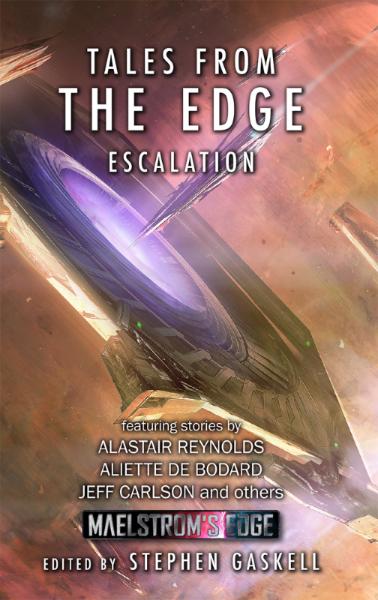Painting Tutorial: Heat Stress
Posted on Monday Sept 18, 2017 at 05:00pm in Tutorials
- by Iain Wilson
If you're tired of painting your weapon barrels silver and calling the job a good'un, this week's tutorial is for you! Here, we're going to run through how to paint a heat stress effect using Army Painter inks, perfect for Clingfire sprayers or Maglock Chainguns to make them really pop on your models.
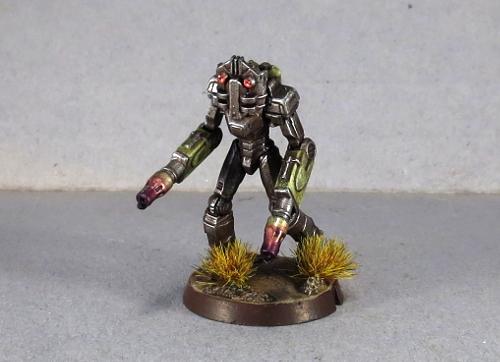
Start with a basecoat of metal. Here, I've used P3 Pig Iron, equivalent to Citadel Leadbelcher (Boltgun Metal, for the old-timers).
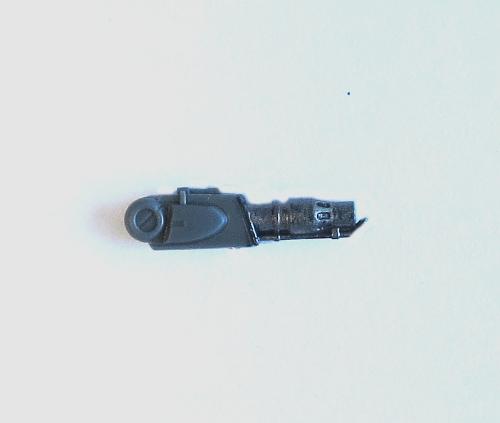
Paint the part that you want to be heatstressed with gold. I've used Coat D'arms Bright Gold here, but any gold will do.
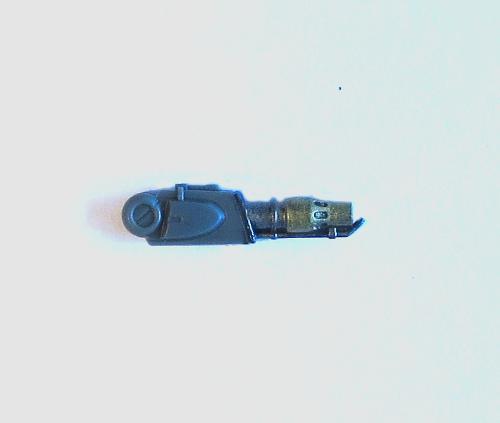
Next, leaving a thin strip of gold at the end furthest from the weapon muzzle, paint the gold area with several thin coats of Army Painter Red Tone. Avoid trying to rush it by slopping the coats on too heavy, as that can cause the colour to go all blotchy. Keep the coats thin and let them dry thoroughly in between (which doesn't take long if you're keeping them thin!), and start each coat just a little bit further away from the start of the gold section, so that you build a natural transition from the gold to the red. Don't be concerned if the first coat or two doesn't look like it's actually doing much - it's a cumulative effect and the colour will build up as you keep going over it.
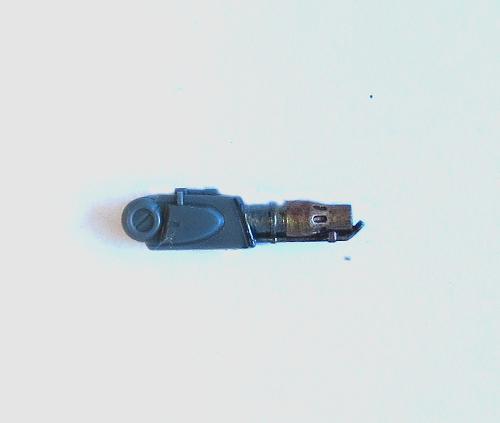
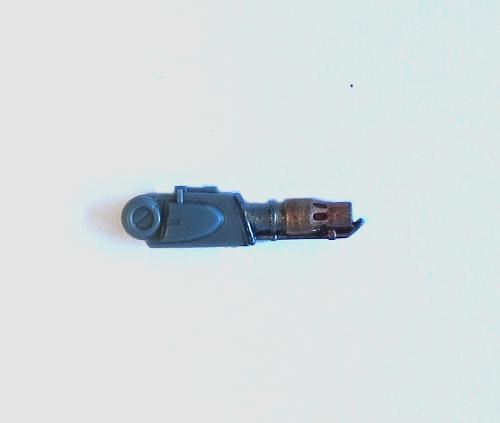
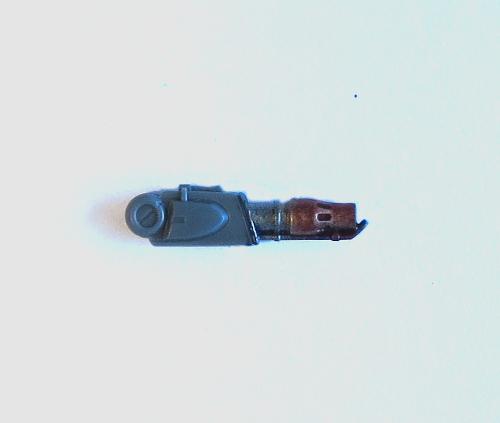
(in case you're wondering, we're doing this with inks rather than normal paints because the ink lets the metallic sheen show through.)
Once you have built up the red to a level you're happy with, switch to Purple Tone. Leave a section of red, and then build up a few layers of purple, starting each layer a little closer to the muzzle of the weapon to build up the transition from red to purple. As before, use thin coats and let each one dry thoroughly before starting the next.
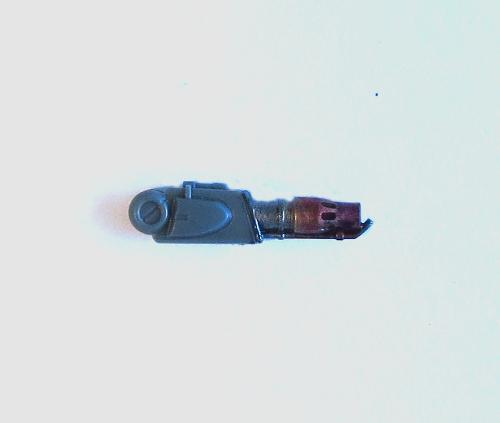
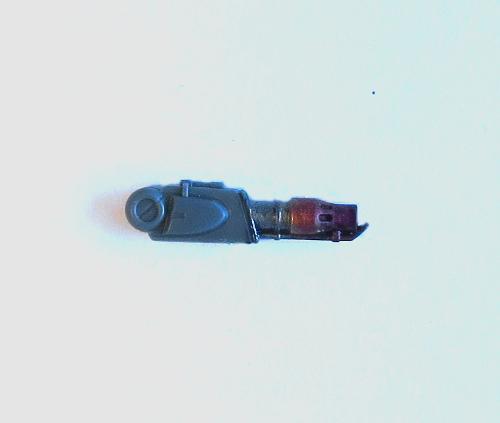
You can also stretch it out a little on longer barrels by using some Blue Tone in between the red and the purple, to give a more gradual transition from red to lighter bluish-purple to darker purple.
Finally, paint the muzzle of the weapon black. Thin the paint a little and work it back into the purple slightly, giving a sooty appearance to the muzzle area.
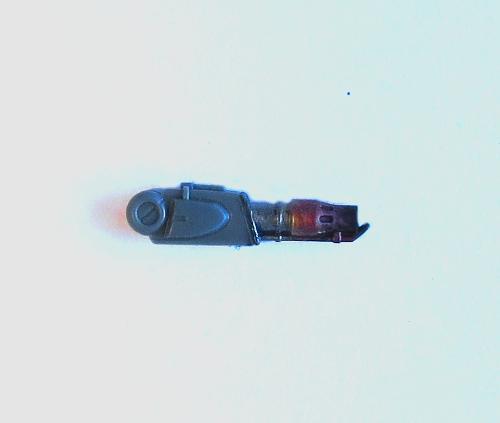
If you like your weapons looking a little cleaner, you can leave off that last step and just finish with the purple.
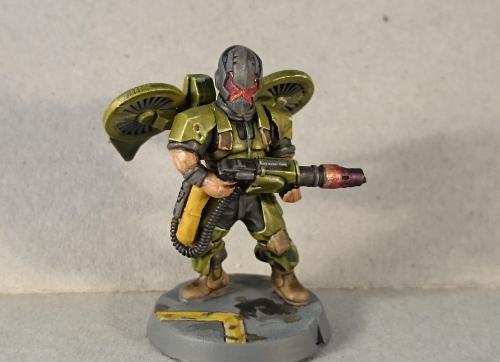
To build your own army of scorchy, melty doom, you can pick up the full range of Maelstrom's Edge miniatures and terrain accessories from the webstore here. As always, feel free to share your creations on the Comm Guild Facebook page!
For other Maelstrom's Edge modeling articles, including tutorials and walkthroughs of a wide range of different building and miniature projects, check out the article roundup here.
Tags: modeling painting tutorial walkthrough
Terrain Tutorial: Streetlights
Posted on Monday Sept 11, 2017 at 05:00pm in Tutorials
- by Iain Wilson
When you're putting together an urban table, little 'real' details can help immensely to bring it all to life. With that in mind, we shared a tutorial a little while back for creating simple hedges made from kitchen scourers and flock. This week we're adding to the urban chaos, and using up some of that leftover sprue, with some quick and easy streetlights.
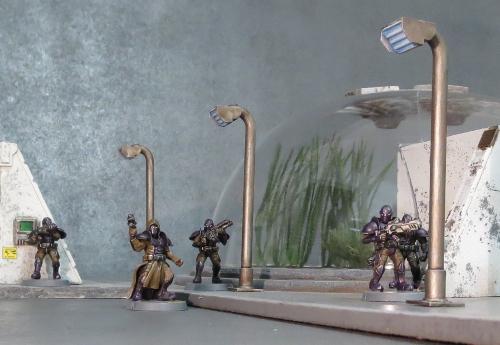
The Maelstrom's Edge terrain sprue has a whole slew of useful components on it, but it also has a nice, rounded frame that is itself rather handy for making pipes, railings or, in this case, streetlight poles. I'm using three emptied sprues (the smaller side of the two frames that make up the terrain sprue), three small pipe fittings, a striplight, some 6mm plastic tubing and some .75mm plasticard.
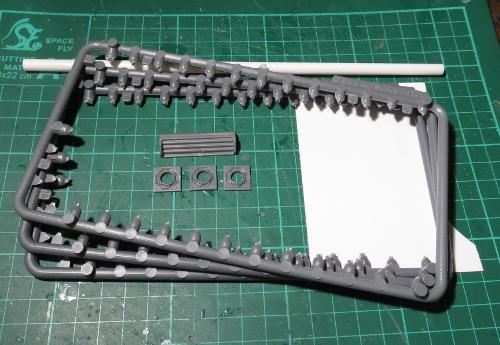
The first step is to take the striplight and cut it into 3 sections. You can do this with a sharp hobby knife if you're patient and not too attached to your thumbs, but a razor saw and hobby mitre box makes the job a lot easier.
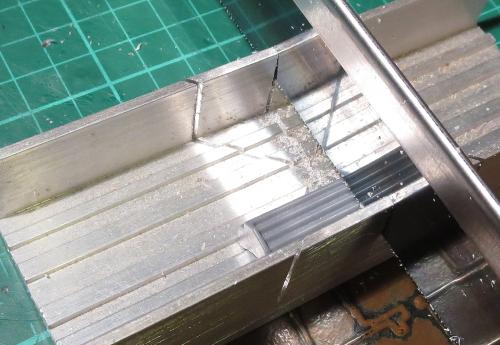
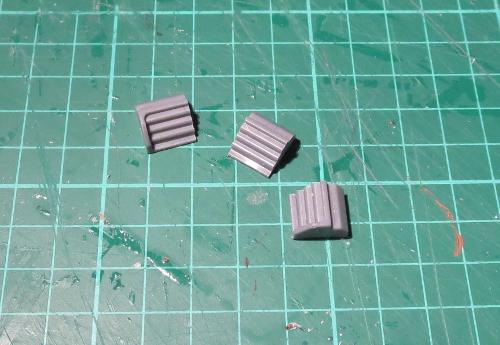
Trace around one of the end sections of the cut striplight to transfer the shape of the light's side panel to the plasticard, and then cut out four panels - 1 each for the light sections from either end, and two for the middle section.
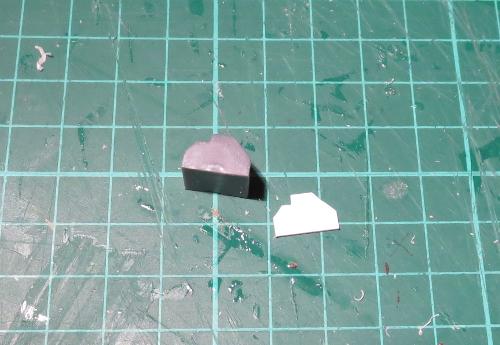
Glue these panels in place. Once the glue is dry, you can shave or file the edges of the panels down so that they are flush with the shape of the light.
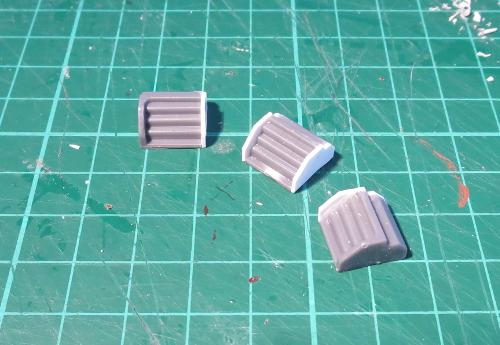
The sprue frame has one end that has no connection tabs on it. This end will form the pole for the light. Cut three of them as below:
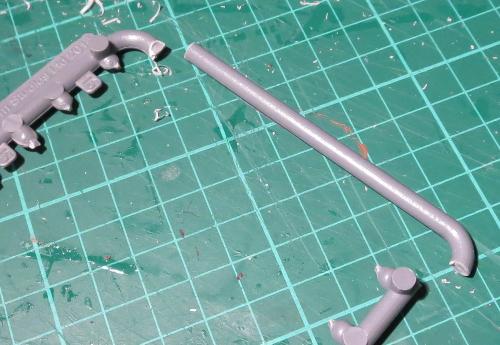
On the straight end of each of the poles, add a short piece of the plastic tube - I've used a 10mm section, but the exact length isn't important so long as it's consistent on all of your lights.
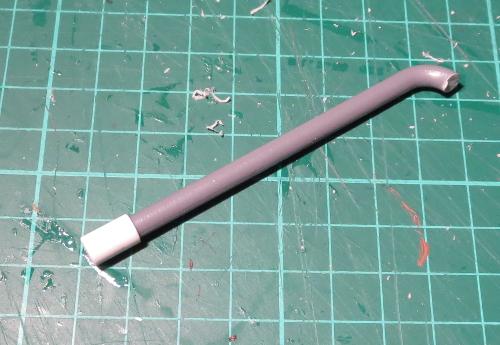
The tube then goes into the pipe fitting.
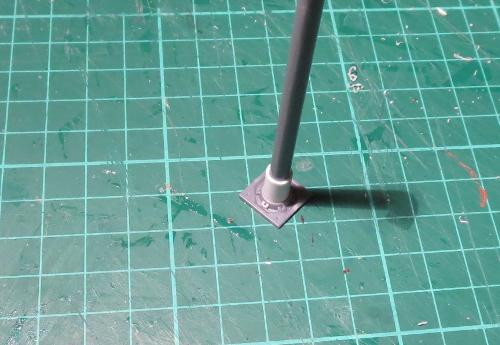
From the leftover sprue, cut three identical connection tabs.
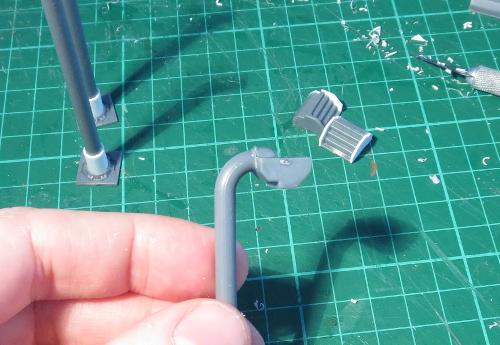
The light is glued in place on the bent end of the pole, and the connection tab is glued on top to add a little detail and bulk up the joint to match the end of the pole.
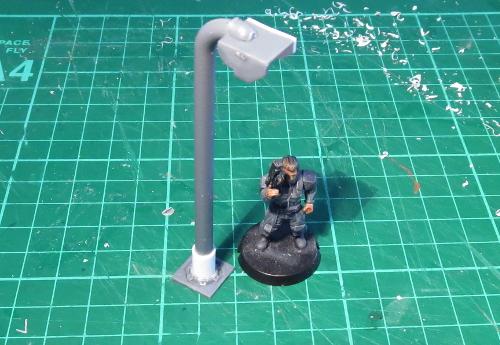
If you're intending to glue the lights onto your terrain, then you're done (aside from painting, obviously). If you want to be able to use the streetlights as scatter terrain, then you might want to glue them to a slightly larger base to make them more stable. You could use a small circle of MDF or plasticard, a spare miniature base, or alternatively the square hatch from the terrain sprue serves for a more high-tech solution.
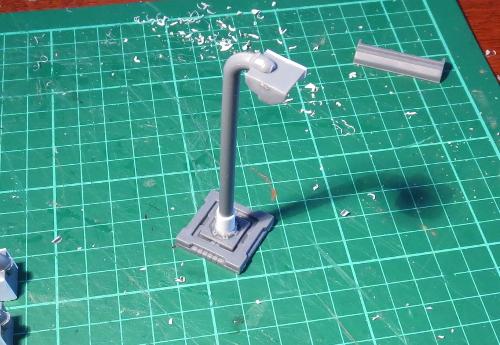
From there, it's all down to painting. The lights shown here have been painting using the weathered metal formula that features in so many of my articles - You can find the tutorial here.
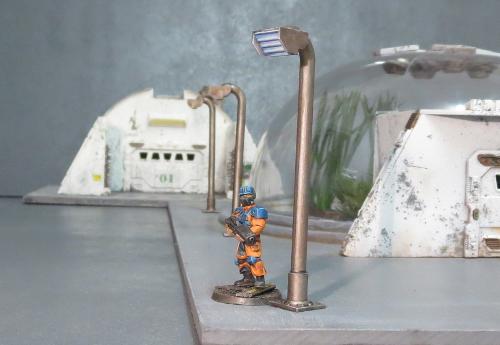

And that brings us to a close once more. Time to pop the chairs up on the tables, grab our umbrellas and saunter off into the gathering dusk...
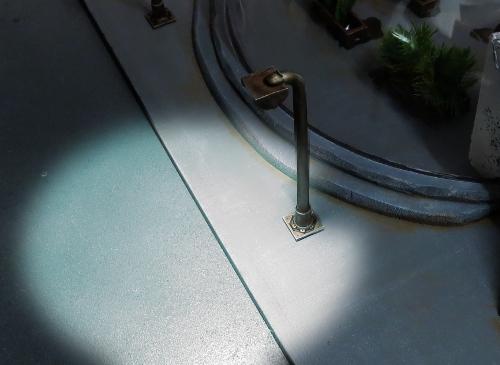
To put together your own scifi urban utopia, you can pick up the Maelstrom's Edge terrain sprue in a handy two-pack from the webstore here.
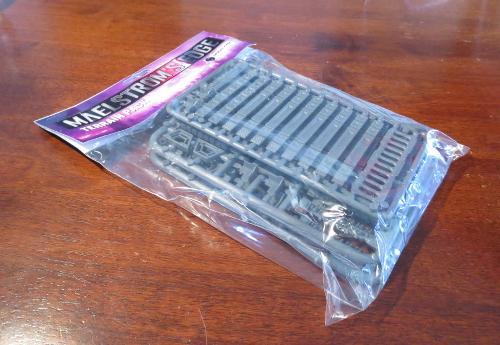
As always, feel free to share your creations on the Comm Guild Facebook page!
For other Maelstrom's Edge modeling articles, including tutorials and walkthroughs of a wide range of different building and miniature projects, check out the article roundup here.
Conversion Spotlight: Kaddar Militant
Posted on Monday Sept 04, 2017 at 05:00pm in Models
- by Iain Wilson
The range of plastic miniatures available for Maelstrom's Edge covers all of the units and options currently available in the game. There's a lot of fun to be had by taking those miniatures and exploring other options beyond the current limits of the game, whether to field with home-brew rules or just for one-off display pieces to flex the creative muscles. This week, we're looking at a model from the latter category, built just for fun, because it never hurts to have a bigger stick.
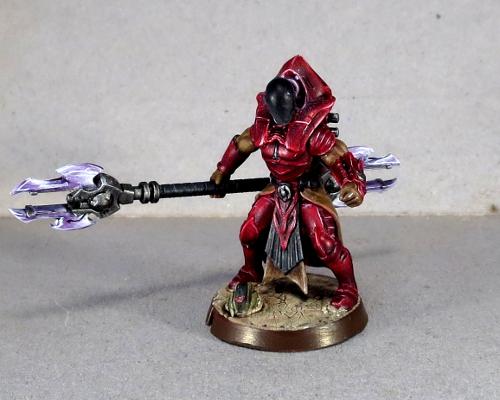
When the Faction Expansion Sprue was released, I took one look at the awesome cybel glaive on the sprue and couldn't resist the urge to create a double-ended version by sticking the head of one glaive onto the bottom end of the shaft of a second. The resultant, admittedly slightly over-the-top, marvel of blades and energy emitters needed a suitably awe-inspiring model to carry it, so I turned to the ever-imposing Kaddar Nova kit.
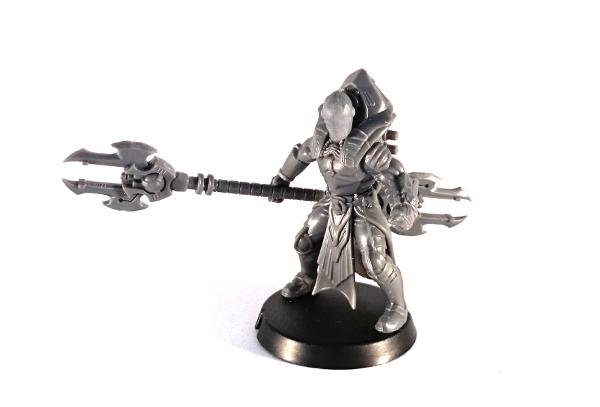
The head is taken from the Karist Trooper kit, with the front sanded down smooth.

Painting started out with a basecoat of Army Painter Dragon Red. From there, I built up shadows using thin, multiple layers of Army Painter Purple Tone, before higlighting the edges with white and then a final wash of Army Painter Red Tone over the top to mesh everything together.
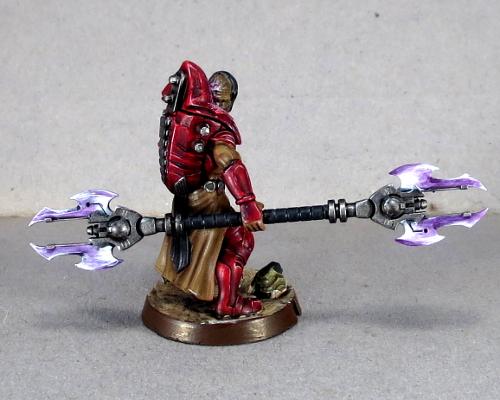
The cloth parts were painted with Vallejo Heavy Brown, and then shaded with layers of Army Painter Strong Tone. Similarly, the black parts were painted with Vallejo Heavy Grey, highlighted with some Vallejo Neutral Grey and then shaded with Army Painter Dark Tone.
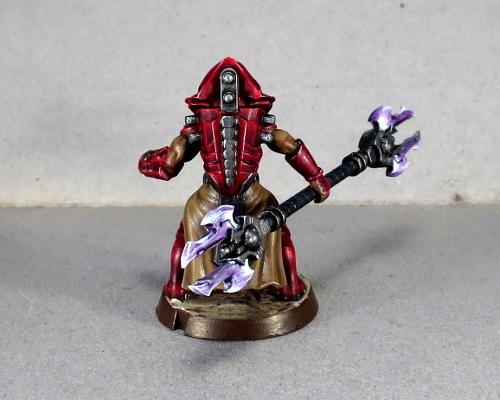
Metal parts started with some more Heavy Grey, and then a coat of P3 Pig Iron, and finally a wash with Dark Tone to give it some depth. Finally, the glaive blades were painted white and then worked up to the purple with layers of Purple Tone. The panel behind his head was given some purple light with a layer of Citadel Warlock Purple, drybrushed with a little Citadel Tentacle Pink and then a final drybrush of white.
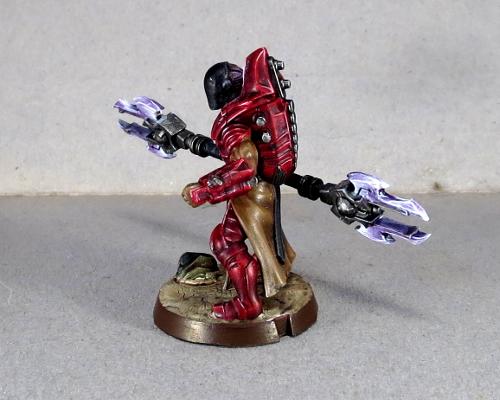
The end result is a spiky, sinister-looking character who will probably wind up spawning yet another Karist force in my collection. I'm thinking of this guy as a 'Kaddar Militant' - a subsect of the Kaddar Priest class, who lean a little more towards brutal subjugation to get their way than is the norm for Karist forces. Stay tuned - there may well wind up being a rules card at some point in the not too distant future, tweaking the standard Kaddar Nova rules to allow for the double-ended Glaive and some revision to the normal unit selection matrix.
If this has inspired you to get creative with some plastic, you can pick up the Maelstrom's Edge terrain sprue from the webstore here. As always, feel free to share your creations on the Comm Guild Facebook page!
For other Maelstrom's Edge modeling articles, including tutorials and walkthroughs of a wide range of different building and miniature projects, check out the article roundup here.
Tags: conversion kaddar karist modeling painting
Previewing the Broken
Posted on Wednesday Aug 30, 2017 at 06:27pm in The Broken
As the release of The Broken gathers speed, it is time to share some more photos of the upcoming models with you. All of these can be built using our plastic kit. The kit will allow three different units or an HQ model to be assembled from it, so the 4 sprues that make up the kit will be a solid foundation of any Broken force.
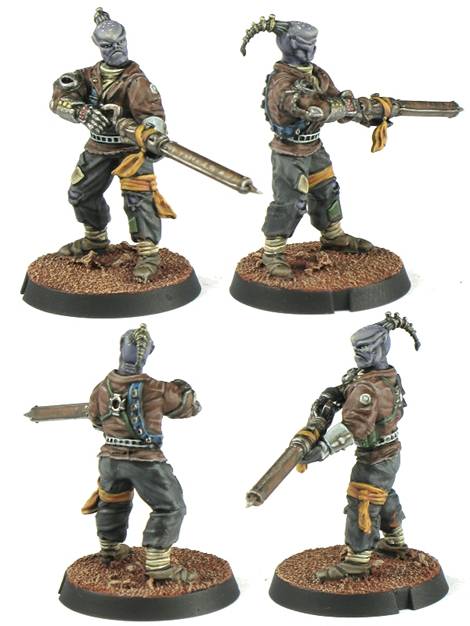
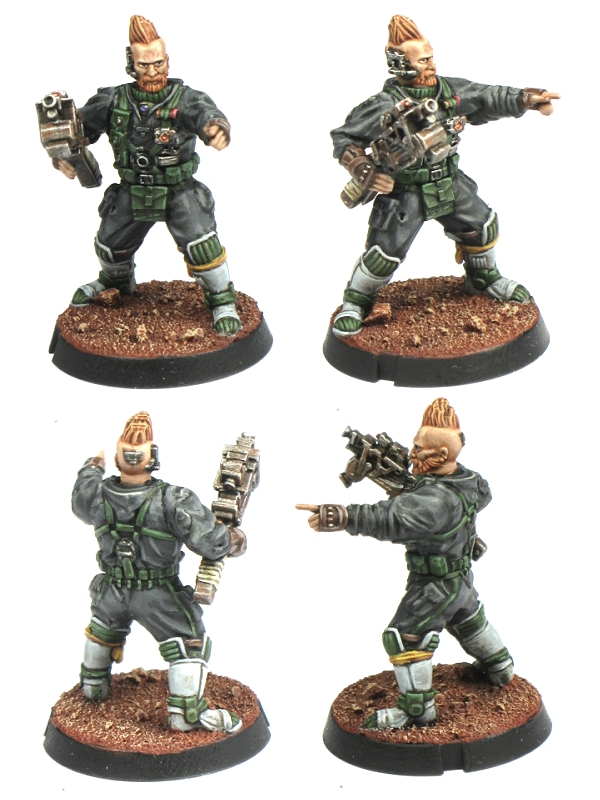
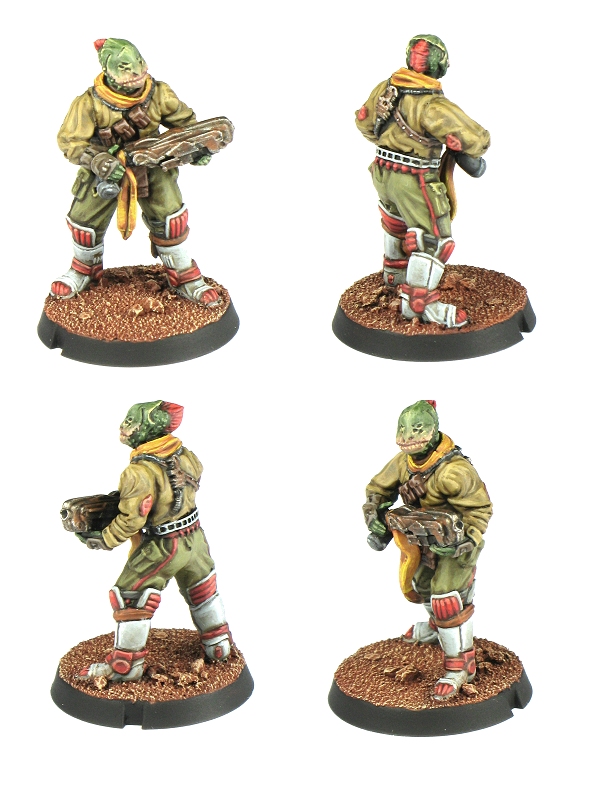
Keep your eyes on the comm guild blog, our facebook page, or make sure your email address is registered at http://www.maelstromsedge.com to be notified when the Broken go on sale in Sep 2017.
Army Spotlight - Karist Strike Force
Posted on Monday Aug 28, 2017 at 12:00am in Models
- by Iain Wilson
A little while ago I shared an Epirian bot army that I had been assembling, which you can find here if you missed it the first time. It didn't seem like the done thing to let all of those blasphemous machines hog the limelight, and so this week it's time for the pure and wholesome forces of the Karist Enclave to shine.
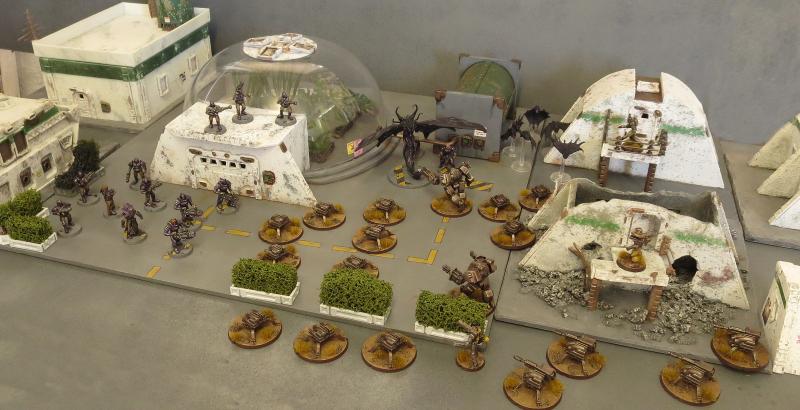
I wanted a Karist leader with a bit of presence - the sort of no-nonsense character who would stride about the battlefield secure in the rightness of his cause and confidence in his inevitable victory. So I took the Kaddar Nova kit and modified the legs slightly to give him a walking pose.
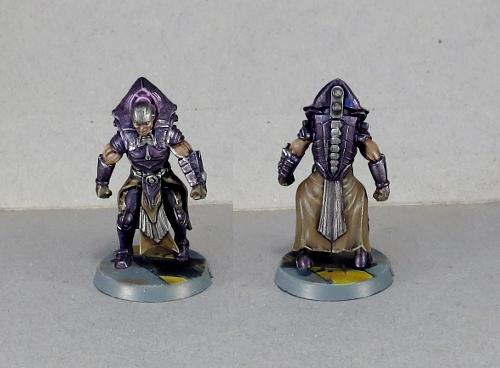
The conversion involved cutting some plastic away from the groin where the two leg pieces join, to bring the legs in for a more upright pose. One leg was angled slightly back by rotating at the waist joint, and the ankles were carefully twisted to straighten them out. The end result is a walking but slightly bow-legged pose, which helps to show the weight that the Nova is carrying around with that backpack!

The painting on this force is quite simple, as I wanted something quick and easy that I could expand on later as I add more models to the roster. The purple is an old Citadel metallic purple washed with Army Painter Dark Tone. The brown cloth sections painted with Vallejo Heavy Brown and washed with Army Painter Strong Tone form a nice contrast to the purple, and the weapons are painted in a no-nonsense metal scheme using P3 Pig Iron washed with Dark Tone.
While I was aiming for a fairly small, elite force this time around, I still needed a unit of Troopers to fill in the required Core slot. I decided to go for a 5-man unit, to help them stand out from the more compact specialist units I was going to include and to give help them last a little longer once they get in range of all those Epirian guns.
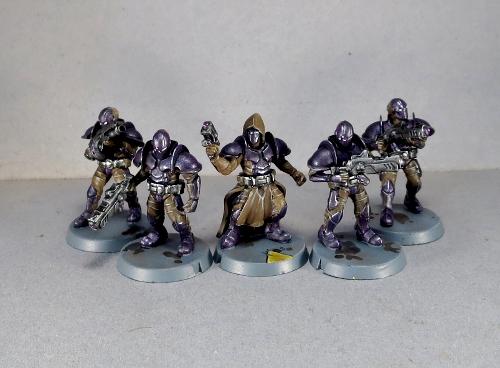
The Quintarch for this unit was based loosely on an early piece of Maelstrom's Edge artwork, with robes made from a leftover Kaddar Nova robe and some green stuff putty.
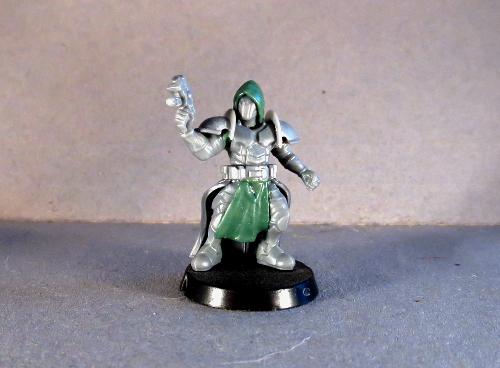
A unit of Tempest Elites provide some fire support, with their fearsome Hellstorm Energy Mortars.
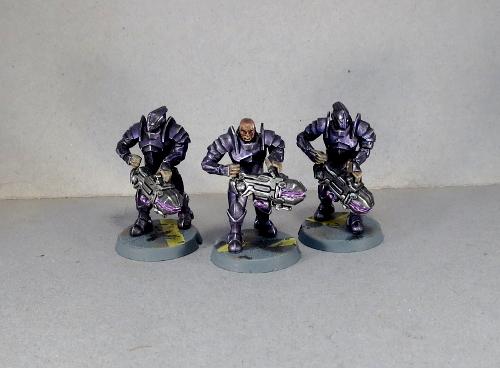
For some extra firepower where it counts, I included a Reaper Cadre. This is a homebrew unit that I put together for an article a while back. They're basically elite troopers armed with a long rifle version of the Pulse Carbine. You can find the conversion article and a rules card here.
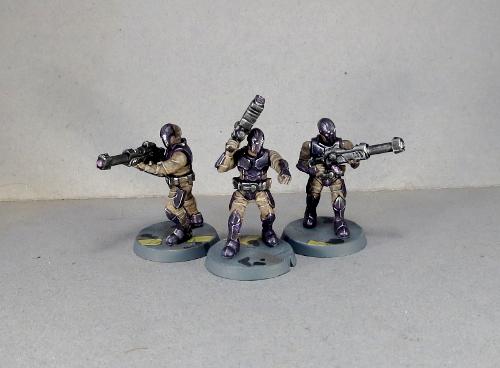
I obviously needed to include some angel units, and to keep them in line I also took along an Angel Keeper. He forms the HQ option for a second detachment.
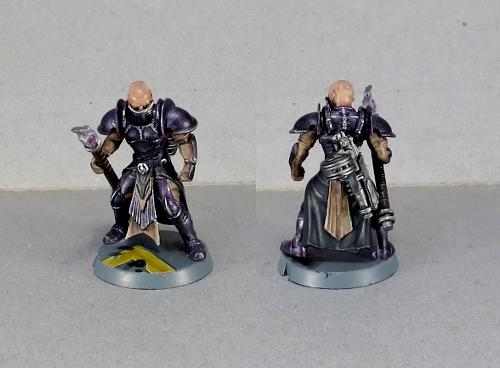
The Keeper is a playtest unit offered up some time ago for those who wanted some extra angel-related shenanigans in their forces. The model is a conversion using parts from a few different kits, as there is no official model (yet!) for it - you can find the conversion tutorial and rules card here.
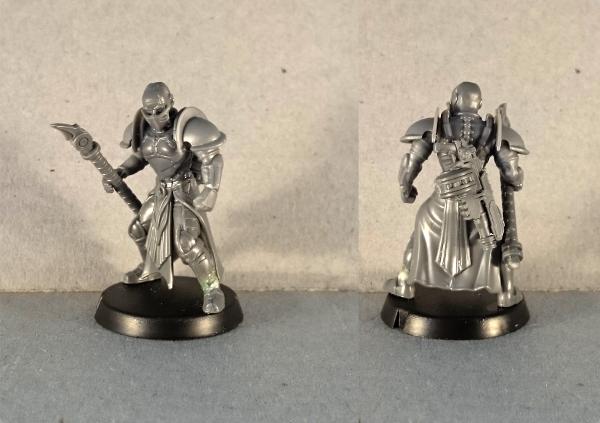
In the Keeper's charge are a unit of Minnows. These were converted to add some extra motion to their poses, by mixing up the pairing of the wing parts and filling in any resultant gaps with a little green stuff.
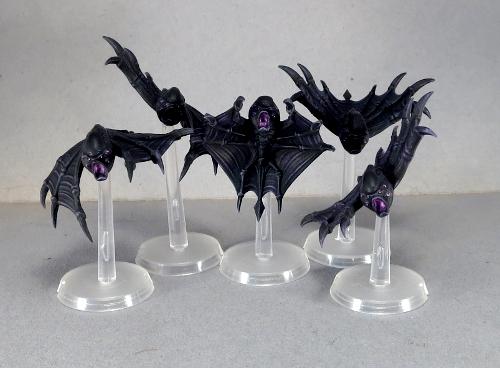
The Minnows' big brother rounds out the second detachment for now. I put together a model of a Mature Angel in its flight form a while ago, and so he had to go into this force. This model was built using the body from the Mature Angel kit, a tail made from green stuff and some wings from a demon model from the Reaper Bones range. You can find a walkthrough of the conversion here
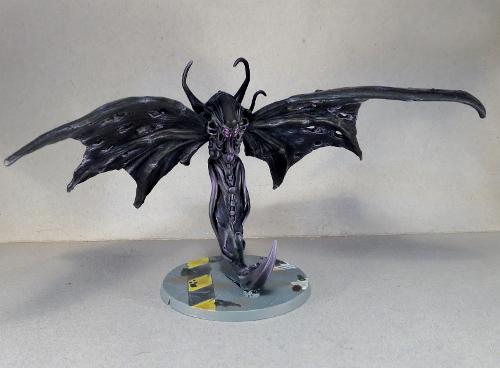
The force all together:
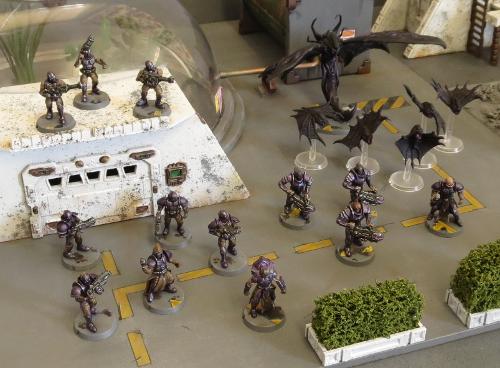
This leaves me with a roster that looks something like this:
Detachment 1
Command: Kaddar Nova - 15 points
Core: Karist Troopers
- Ripper Grenade Launcher - 18 points
Hammer: Tempest Elites
- Hellstorm Energy Mortars - 25 points
Vanguard: Reaper Cadre
- 2 Pulse Lances - 15 points
Detachment 2
Command: Angel Keeper
- Ripper Grenades - 10 points
Core: Angel Minnow Pack - 10 points
Anvil: Mature Angel - 23 points
Total - 116 points.
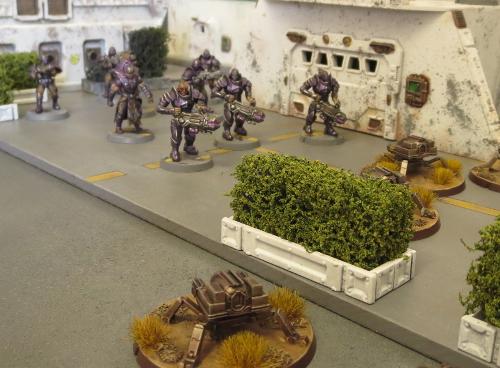
If you would like to put together your own Karist strike force, you can pick up the various Maelstrom's Edge kits from the webstore here. As always, feel free to share your creations on the Comm Guild Facebook page!
For other Maelstrom's Edge modeling articles, including tutorials and walkthroughs of a wide range of different building and miniature projects, check out the article roundup here.
The Maelstrom's Edge Fiction Creative Process
Posted on Thursday Aug 24, 2017 at 07:18pm in Fiction
by Tomas L. Martin
When I joined the team designing Maelstrom’s Edge in 2011, it was a small team with a great vision. We wanted to create not just a fun and challenging wargame with a bunch of cool-looking multipart plastic models to go with it, but to also design a new science fiction universe that the game and models would fit into. We wanted to bring a broad and complex world to life, somewhere deep and exciting where the tabletop battles would feel like a natural extension to the stories we told in the background fluff and fiction.
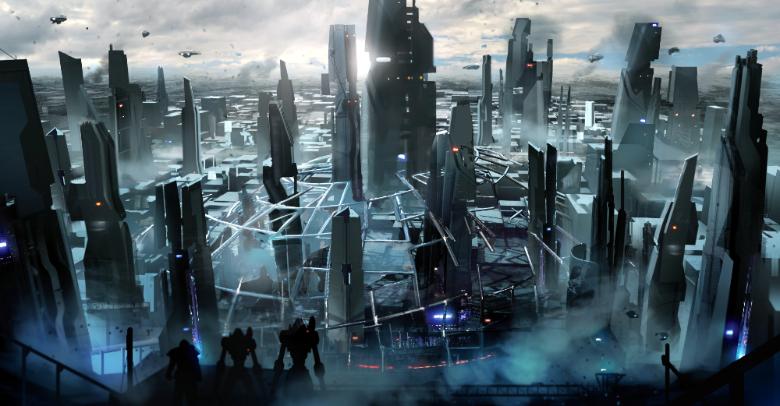
Stephen Gaskell and I signed on as lead writers to write the kind of fun space opera stories we loved reading and watching ourselves. Together with the rest of the design team, we would throw around influences that got us excited. The classic settings of Star Wars, Dune and Alien were all mentioned, as they are for many science fiction creations across the years. But it was the dark, morally grey confrontations of the remade Battlestar Galactica TV show that made the most frequent appearance in those discussions, as well as the wise-cracking, fast-paced action of Firefly.
We loved the idea of a universe where it made sense for there to be the kind of skirmishes and battles that the tabletop game depicted. Somewhere right on the bleeding edge of civilisation, where every day was a fight to survive and get the resources you needed, and where characters would be forced to make hard, morally complex choices, where the readers of our work could see both sides of the coin, and be genuinely torn as to what the right choice would be.
It wasn’t just the science fiction settings and heroes of the screen that inspired us. We also took a lot of inspiration from the great works of science fiction written on the page in the last few decades. Amazing writers like Peter Hamilton, Iain M. Banks, Neal Asher and Alastair Reynolds, who would tell big sweeping stories of interstellar conspiracies and wars, whilst keeping a certain balance between gritty action and scientific realism. Vibrant new writers like Aliette de Bodard, Tobias Buckell, Karin Lowachee and James S.A. Corey, who combined vibrant language and unusual characters with deep and interesting worldbuilding.

Stephen and I took inspiration from many of these great writers when we wrote the first set of short stories to cultivate the universe of Maelstrom’s Edge, stories that later were collected into the short story anthology ‘Tales from the Edge: Emergence’. We kept thinking of the fantastic peers we had in the science fiction realm when we co-wrote what would become the first two Maelstrom’s Edge novels, Faith and Sacrifice. And we continue to think of these influences today as we move forward to design the stories and background of future Maelstrom’s Edge releases.
Which is why it’s an incredible honour that such a large number of the authors we admire greatly agreed to contribute short stories set in the Maelstrom’s Edge anthology, Escalation, which is out now on the Kindle Store. Having the expertise of writers like Nebula and Hugo award winning Aliette de Bodard, or the Philip K. Dick award-nominated Karin Lowachee and Liz Williams, was a huge coup for us and we’re delighted with the stories that they have given us for the anthology. Likewise to have such influential authors as Jeff Carlson and Alastair Reynolds writing in the Maelstrom’s Edge universe has been an incredible pleasure, and we hope that you enjoy their adventures in our creation just as much as we have.
Tags: creativeprocess fiction
Terrain Spotlight: The Galactic Wanderer
Posted on Monday Aug 21, 2017 at 05:00pm in Models
- by Iain Wilson
When I shared my Hedge Tutorial a few weeks ago, there was a comment made that they looked like they would be right at home in some sort of scifi trailer park. Well, I'm not one to let a challenge like that go unanswered, and so... the Galactic Wanderer was born.
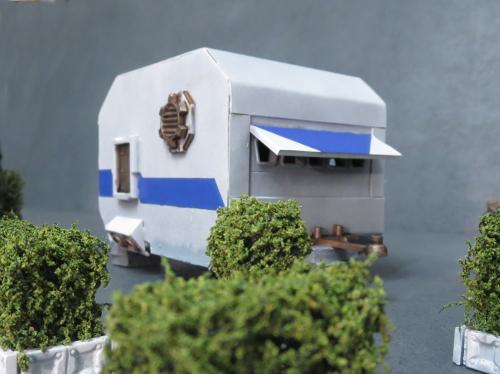
Like many of my terrain builds, this all started with some foam core and a bunch of parts from the Maelstrom's Edge terrain sprue.
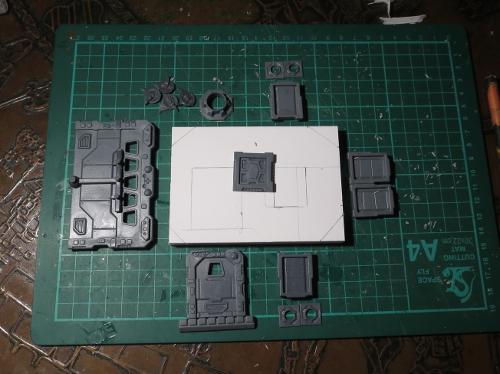
I cut a fairly basic, old-school caravan shape from the foamcore, and cut holes for a door and some windows.
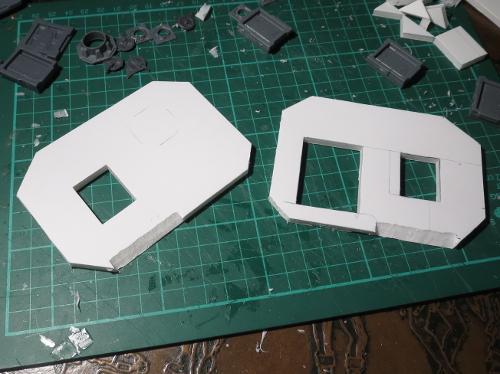
The body of the caravan was glued together with foam glue (a white glue that I picked up a while back. It may well just be overpriced PVA glue, but it does a good job of gluing foam and grabs a little faster than a lot of PVA glues that I have tried) and the door and windows glued in place.
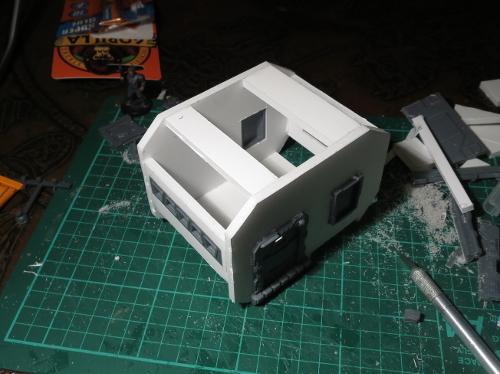
A strip of windows cut from a garage door fit quite nicely along the front wall.
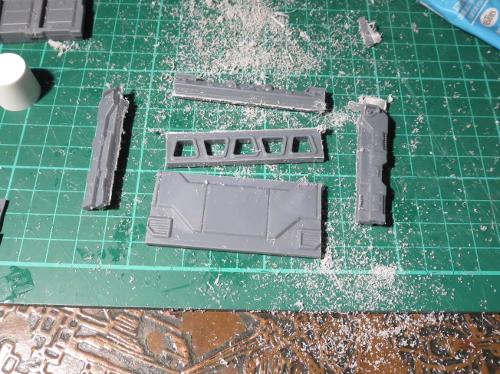
An awning cut from a piece of 2mm plasticard provides a nice break in the regular shape of the caravan, and is totally there for aesthetic reasons and not at all to help conceal the fact that the strip of windows actually wound up just a little bit wonky. I also added a towbar made from a section of old sprue, a hatch in the roof, and rested the construction on some 'bricks' cut from discarded pieces of foamcore.
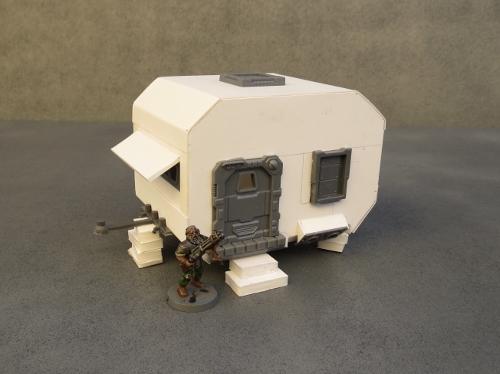
To help with the scifi vibe, unstead of wheels this caravan has some turbines made from the small pipe fitting from the terrain sprue with some turbines from the Epirian Drone sprue behind them. And finally, a large pipe fitting, trimmed off with a razor saw and with some strips of plasticard glued inside provides some ventilation.
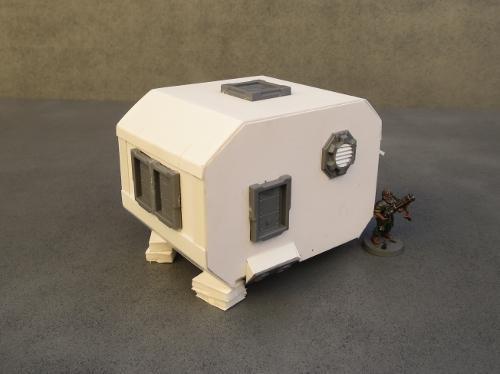
A quick spray and some striping later, and the compact, budget-conscious home of the future is ready for housing stellar refugees or indulging the wanderlust of the more well-to-do.
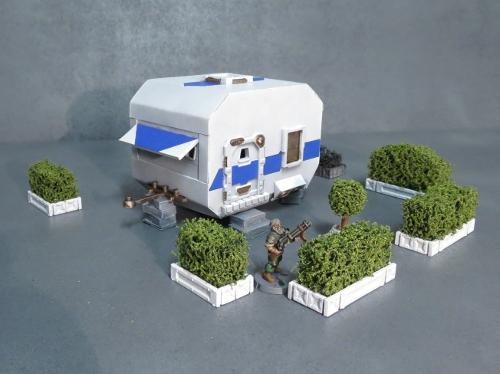
A better look at the caravan's 'wheels':
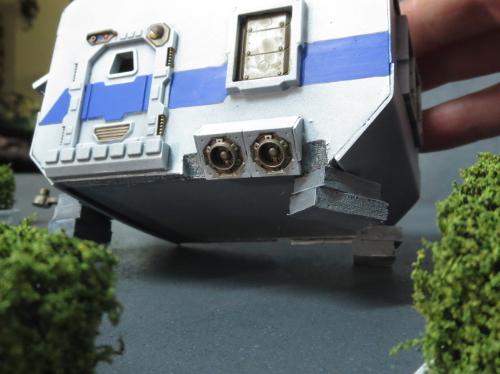
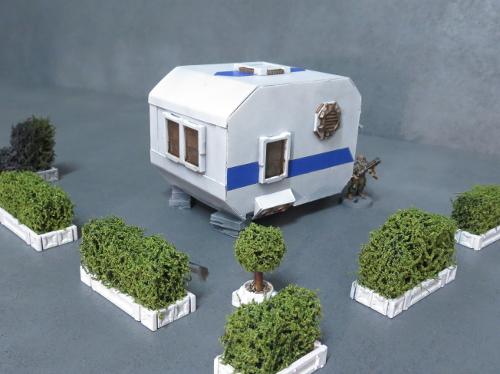
To build your own holiday villa or mobile refugee camp of the future, you can pick up the Maelstrom's Edge terrain sprue from the webstore here. As always, feel free to share your creations on the Comm Guild Facebook page!
For other Maelstrom's Edge modeling articles, including tutorials and walkthroughs of a wide range of different building and miniature projects, check out the article roundup here.
Tags: buildings modeling spotlight terrain terrainsprue walkthrough
Assembly Guide - Karist Praetorians
Posted on Monday Aug 14, 2017 at 05:00pm in Tutorials
The assembly guides on the Maelstrom's Edge website are missing the new units added by the Faction Expansion Sprue. Last week, we went over the assembly of the Epirian Suppression Team, and so this time around we'll look at the other unit created from the sprue, the Karist Praetorians.
Karist Praetorian Assembly Guide

General Notes
Polystyrene cement - only use superglue if you want to go insane! All of our models are designed to be assembled with polystyrene cement as it gives some time to re-pose while gluing, fuses the models together and prevents brittle joins like other glues do. Make sure you have polystyrene cement in your toolkit before you begin!
We want you to experiment! We've broken our models up into lots of parts and given a fair few spare parts so that you can push yourself out of your comfort zone, learn new skills and create some really unique models. We've tried to price things so that it won't break the bank if you make a mistake, so please cut stuff up and have some fun. Start simple with a slice here and a re-pose there, and watch your confidence and skills increase until you are a master modeler!
Basing - Always make sure you glue your model to its base with an eye on the arc markers on the sides of the base. The arc marker indents should be at the halfway point between the front and back of the model to show the front and back halves of the model when gaming. See the Maelstrom's Edge rulebook for more detailed notes on this.
Dry fit before gluing! - There are lots of pose options possible, but that means there is also the freedom to screw up and make some bad poses! Sticking the parts together and seeing how things look will usually lead to a model that is fairly static and repetitive. You should consider knee, hip, torso, and arm positions when gluing and ensure that you have a pose in mind before you start gluing things together. If in doubt or insecure about your talents in the posing area, we recommend you try to copy the poses from some of our studio models found here in the gallery.
Karist Praetorian Assembly Notes
Karist Praetorians are fairly straightforward to assemble, being just a modification of the basic Karist Trooper. Three models can be assembled using the following sprues:
Karist Trooper Sprue:
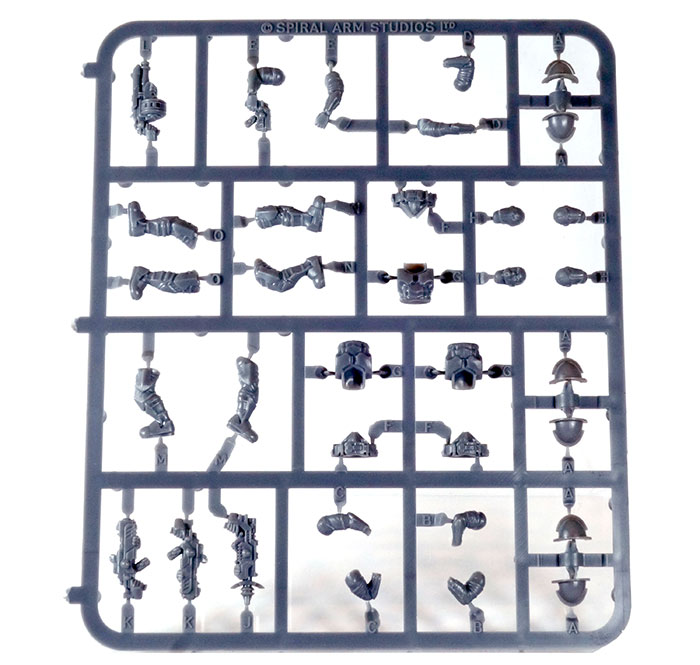
Faction Expansion Sprue

You will need the below parts from those sprue. We've used one rifle and one pistol just to show how they go together, but you could of course choose to use all rifles or all pistols when you assemble your own unit.

One design decision that might seem a little odd is the splitting of the legs from the lower torso/crotch piece. This had to be done because the upper leg armour is not possible to mould in injection moulded plastic without having to make some ugly tweaks to it that would have really reduced sharpness beyond what we were willing to tolerate. We decided to split the legs at the top instead, allowing ease of conversions and sustaining the crisp armour plates.
All three lower torsos (part F) are identical, as are all three torsos (G). Legs are paired with the same letter (eg; part M is both the left and right leg of the same pose). We recommend the first step in your Karist Trooper assembly should be sticking the legs on the lower torsos.
Add the loincloths next, as this is easiest before there are other parts to get in the way. There is a recess on the inside top of each loincloth that fits neatly over the groin armour. All three loincloths work with all three leg poses, but as usual it's a good idea to do a quick dry-fit before gluing to check that they look how you want them.

The most complex part of the build is the arm / weapon assembly. This is because three points need to be glued at the same time - the arms to the torso and the hands to the arms. If you are using polystyrene cement, you'll get a minute or two of re-posing time which can make this a lot easier. Arms are paired by code as well (eg; part C is both a left and right arm that go together). Mixing up your paired arms will mean some odd posing!
The shoulderpads (part A) are designed to be optional if you are so inclined - underarm detail is sculpted on the upper arms. We've not made any models without them though as we enjoy the distinctive profile the shoulderpads gives to the Karists. If you postion the arms so that the shoulders are just below the top of the armour, the shoulder pads will butt up neatly against the sides of the torso.

From the Karist Trooper sprue, Part K is the Karist Pulse Carbine. Part J is the Radwave Emitter and part L is the Grenade Launcher.
There is no Karist hand that holds the cybel blade neatly, although with a little conversion you can make the closed fist work. The easiest approach though is to glue the sword to the model's back, where it would presumably be held in place with a magnetic lock.

The cybel glaive does have a hand on the expansion sprue to hold it. You can use any of the right arms from the Karist Trooper sprue for this. Some of the rifle arms have a small wedge of wrist attached to angle the rifle correctly across the body. While not essential, it will look a little better if you cut this wedge off along the front edge of the forearm armour.

Once the hand is attached, you can glue the arm onto the torso, and then the glaive into the hand.
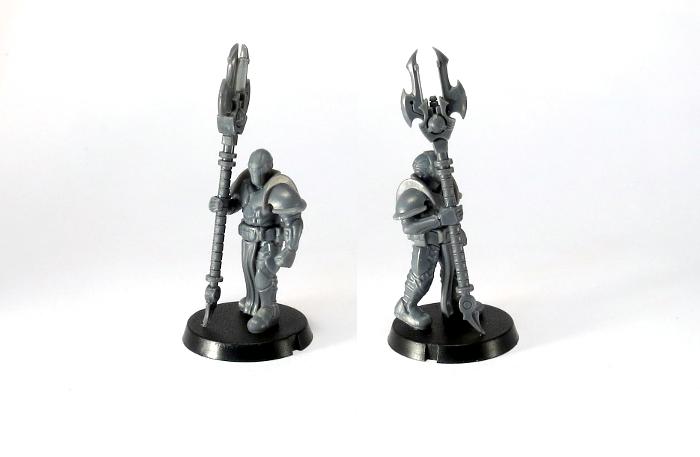
As with most models with poseable heads, we recommend building the whole model and then putting the head in place last of all.

For some more ideas for building or converting your models, check out the Karist Praetorian Spotlight article here.
You can pick up your Contractor and Expansion sprues from the Maelstrom's Edge webstore here. As always, feel free to share your creations on the Comm Guild Facebook page!
For other Maelstrom's Edge modeling articles, including tutorials and walkthroughs of a wide range of different building and miniature projects, check out the article roundup here.
Tags: karist modeling praetorians tutorial
Assembly Guide - Epirian Suppression Team
Posted on Monday Aug 07, 2017 at 05:00pm in Tutorials
The assembly guides on the Maelstrom's Edge website are missing the new units added by the Faction Expansion Sprue. So this week, we're going back to basics and running through assembly of the Epirian Suppression Team.
Assembling Epirian Contractor Suppression Teams
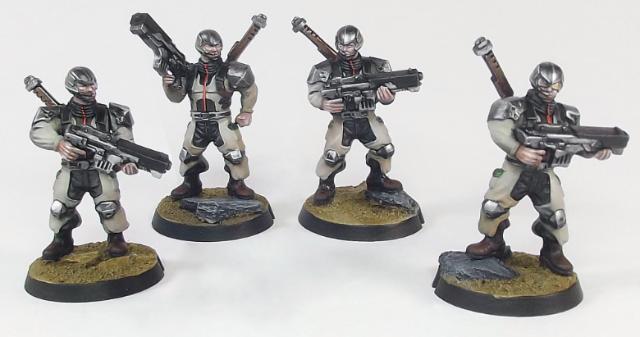
General Notes
Polystyrene cement - only use superglue if you want to go insane! All of our models are designed to be assembled with polystyrene cement as it gives some time to re-pose while gluing, fuses the models together and prevents brittle joins like other glues do. Make sure you have polystyrene cement in your toolkit before you begin!
We want you to experiment! We've broken our models up into lots of parts and given a fair few spare parts so that you can push yourself out of your comfort zone, learn new skills and create some really unique models. We've tried to price things so that it won't break the bank if you make a mistake, so please cut stuff up and have some fun. Start simple with a slice here and a re-pose there, and watch your confidence and skills increase until you are a master modeler!
Basing - Always make sure you glue your model to its base with an eye on the arc markers on the sides of the base. The arc marker indents should be at the halfway point between the front and back of the model to show the front and back halves of the model when gaming. See the Maelstrom's Edge rulebook for more detailed notes on this.
Dry fit before gluing! - There are lots of pose options possible, but that means there is also the freedom to screw up and make some bad poses! Sticking the parts together and seeing how things look will usually lead to a model that is fairly static and repetitive. You should consider knee, hip, torso, and arm positions when gluing and ensure that you have a pose in mind before you start gluing things together. If in doubt or insecure about your talents in the posing area, we recommend you try to copy the poses from some of our studio models found here in the gallery.
Epirian Contractor Suppression Team Assembly Notes
Three Epirian Suppression Team Contractors can be made from the following sprues:
Epirian Contractor Engineer Sprue
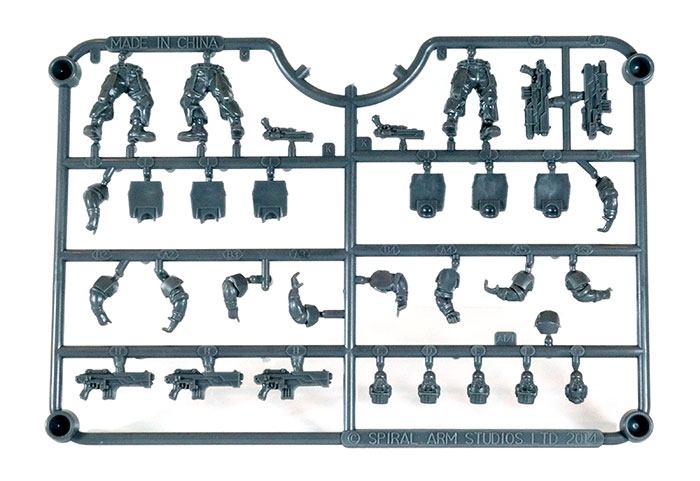
Faction Expansion Sprue

Assembly is straightforward and the two above sprues will make up three models with the following parts. Please note that arms are paired, so do not mix them up or you'll have a really hard time putting them in pairs again! Pairing is done by number, so A1/B1 are a pair, as are A5/B5, etc. You can choose between the rolled-sleeve versions on the Contractor sprue, or the sleeves-down arms on the Expansion sprue.
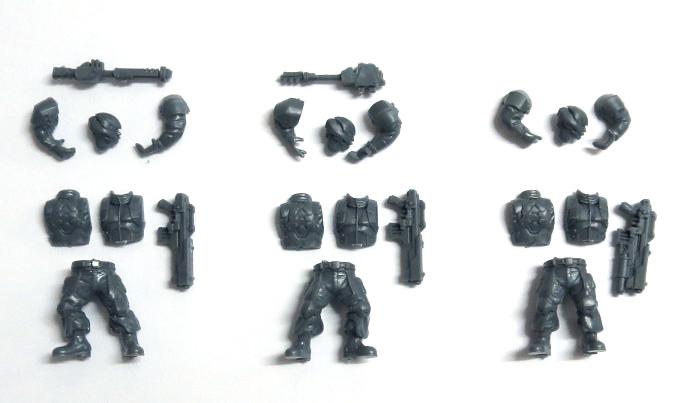
The main build considerations with the Epirian Contractors are that some of the arm poses do not work well with some of the leg poses due to the angles involved, so as always, be certain you dry fit things first. If in doubt, try to copy our studio assemblies for good effect.
As with our Epirian Handler model, the torso has a slight lean to it, and because of that, if you place one foot higher than the other when basing your models, you'll open up much more posing flexibility. This can be done easily by bulking up your basing texture underfoot, adding a pebble or slope to the base, or a multitude of other options.
Cleanup and assembly is fairly easy with the Epirians, with everything going where it should. One point of note is this little mould line on the kneepad strapping:
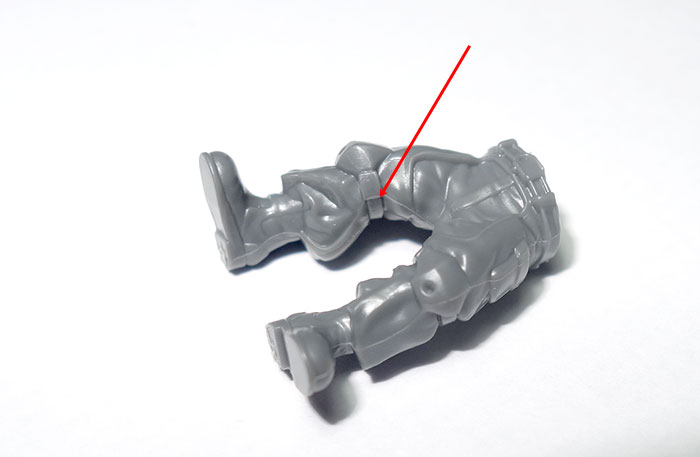
That raised mould line between the front and rear halves of the part looks a lot better if it is shaved down but as it is a little bit deeper than our usual near non-existent mould lines, it can be missed when trimming. Please note that in the photo above we've used a pre-production prototype piece with mould lines that are much worse than our finished products so that you can see more clearly.
Legs, torso and heads go together as you would expect.
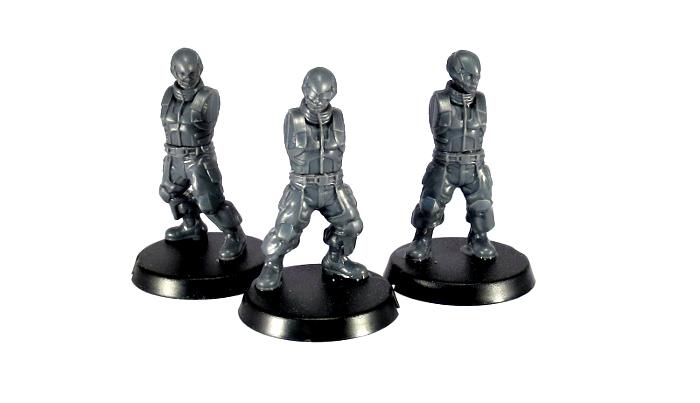
Suppression Team members magnetically lock their 'spare' weapon to their backplate when not in use. So if you choose to have rifles in hand, you can glue the shock weapons to the model's back. Alternatively, you can glue the rifle to their back or sling a pistol off their belt, and put the shock weapon in hand. Use the rifle arms that have the index finger on the trigger, rather than the extended-finger hands - the fingers are close enough together that they still look fairly natural gripping a handle instead of a pistol-grip. The Shock Baton does have a chunkier grip than the Maul, so if you're having trouble getting it to fit, you can shave down the sides of the grip a little.
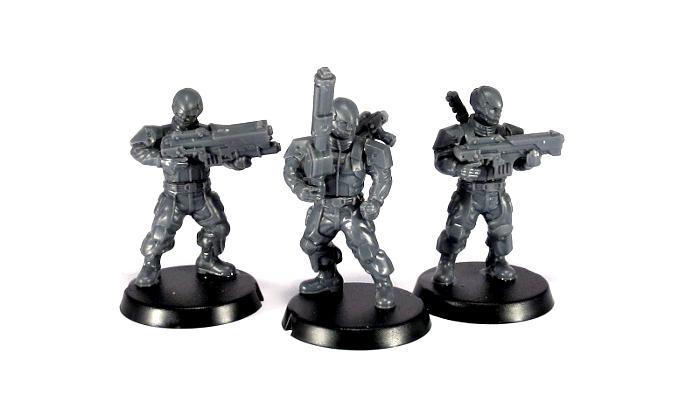
For some more ideas for building your Suppression Team models, check out the Epirian Suppression Team Spotlight article here.
You can pick up your Contractor and Expansion sprues from the Maelstrom's Edge webstore here. As always, feel free to share your creations on the Comm Guild Facebook page!
For other Maelstrom's Edge modeling articles, including tutorials and walkthroughs of a wide range of different building and miniature projects, check out the article roundup here.
Developing Stories for Maelstrom's Edge
Posted on Friday Aug 04, 2017 at 10:00am in Fiction
One of the things we were most passionate about when we started working on Maelstrom’s Edge was making a new world. We love games where there are lots of stories and background material to get people excited about the context surrounding the game itself - where are the battles taking place, who is fighting and why is there a conflict between them?
As part of the initial universe design, our lead writers Stephen Gaskell and Tomas L. Martin wrote a number of short stories exploring different parts of the setting. These first insights into the Maelstrom’s Edge universe were released in our first short story collection, ‘Tales from the Edge: Emergence’. In addition, during the runup to the Kickstarter for the Maelstrom’s Edge game, we approached a number of other professional writers to provide their take on our world, including exploring new factions, planets and ideas. Now, a second anthology, ‘Tales from the Edge: Escalation’ has been released, containing a wealth of fantastic new short fiction from award-winning and bestselling authors such as Alastair Reynolds, Aliette de Bodard, Jeff Carlson and Jaine Fenn.

From the beginning we also knew we wanted to launch with a set of stories telling the backstory of our first set, the Battle for Zycanthus, and so following on from those initial short stories, Tomas and Stephen wrote the fiction that would become our first two novels, Faith and Sacrifice, set on the planet of Zycanthus.
Zycanthus is a frontier planet a few light years from the Maelstrom’s Edge, halfway through terraforming by the Epirian Foundation and their robots. In the boxed game, there is a conflict between Foundation and the shadowy religious group known as the Karist Enclave, who wish to convert the people of Zycanthus to their beliefs about ascension in the presence of the Maelstrom.
To set up the battles that people were going to be playing with their miniatures, our team of writers set out to tell the story of what happened on Zycanthus just before the events portrayed in the box set, when the Karist Enclave first revealed itself and the fighting began.
Initially, the task of telling this story was split into two – Stephen Gaskell wrote a series of stories set from the viewpoint of Zafah, one of the Karist missionaries who lands in secret on Zycanthus, whilst Tomas L. Martin wrote the opposing view of the Epirian Foundation, where a backwater Sheriff called Kyle Wynn uncovers the Enclave’s secret invasion.
We wanted to publish the books ourselves to have the freedom of getting it to our players in whatever format worked best, but printing a book of that size is challenging and would have meant needing to charge more than we felt was appropriate, so we made the decision to split the story into two smaller novels, Maelstrom's Edge: Faith and Maelstrom's Edge: Sacrifice. You can find them in the Kindle store right now.
What follows is an excerpt from Chapter Five of the first book, Maelstrom's Edge: Faith, where a pair of Epirian lawmakers encounter the Karist Enclave, including a monstrous alien Angel, for the first time.
Kyle Wynn is an Epirian Sheriff keeping the peace in the small desert town of Venusai on the planet of Zycanthus. When he and his partner Randall get reports of terraforming robots disappearing in the desert, they head out to investigate. When they find a set of footprints and strange markings in the sand, they follow them, never expecting the dangers they are heading into...
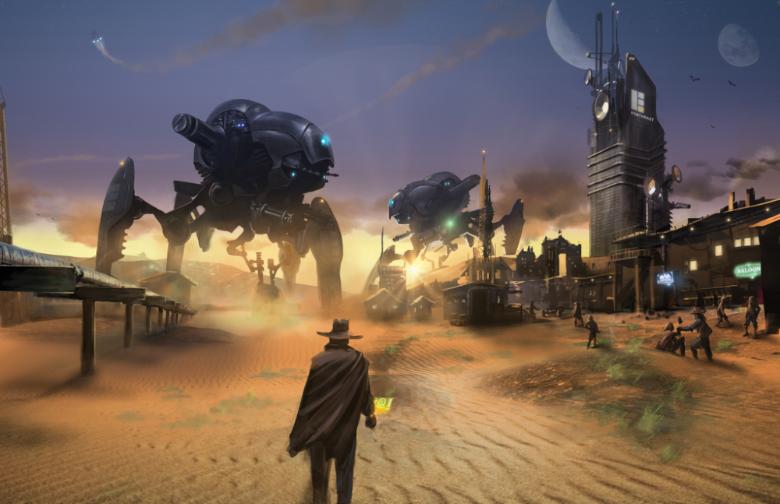
Maelstrom's Edge: Faith, Excerpt from Chapter Five
Wynn and Randall tracked the footprints for several hours. They sent the drones a few klicks ahead of the prowler, set them crisscrossing the trail with infrared cameras. The evening had really started to set in now, and only the dull purple glow of the Maelstrom in the east gave any illumination. It cast cruel shadows in its sickly half-light.
“I hate that thing,” Randall said, staring up at the bruised sky. “Just staring down at us like that, so you never forget that it’s coming.”
Wynn wondered if the Maelstrom was all that was coming to Zycanthus. When he had been a prospector, he’d heard stories from worlds close to the Edge. Before their destruction, there had been reports of strange creatures attacking isolated outposts, shadowy coups, riots and public executions. These stories seemed to get more and more intense and confused as the Maelstrom got closer, ending in tales of destruction that Wynn had always written off as a product of the panic that set in as the planets fell apart.
Now he wasn’t so sure. The footprints continued to march across the sand for klicks, rarely breaking out of their steady pattern. Wynn thought he could spot at least five different tracks, but he also occasionally saw the imprint of something larger, but always indistinct, as if the thing making the impression was hardly touching the ground at all.
They were nearly at the location of the third terraforming drudge when the signal of one of the patrol drones winked out.
“Huh?” Randall tapped a monitor, on which the drone’s sensor feeds had been replaced by static. “Where did it go?”
Wynn said nothing. He was watching the other patrol drone’s feed. It was hovering above a ravine. In the rocks at the bottom, he could see five figures, clad in frost-white armour. Heavy carbines dangled from their shoulders, and canisters filled with purple energy were strung around their waists. They were the most dangerous looking people Wynn had ever seen on Zycanthus, and they were staring straight back at him.
“Randall,” he said, “We have company!”
Wynn flicked a switch and sent the video feed to Randall’s station. Hidden in a hollow, the group of armoured figures stood, checking heavy looking weapons. From the looks of it, they were military, but Wynn didn’t recognise their markings, two scythe like points either side of a circle, deep black against their white armour.
“Who the hell?” Randall said. “Those are not a bunch of kids. When exactly did we get invaded?”
“Apparently a few days ago,” Wynn murmured, studying the footage. The soldiers held themselves bolt upright, with the discipline of many years of training. Their armour was wickedly curved at the edges, and their helmets had only one eye, with a trio of small lenses where the other eye should have been. “They can see the probe,” Wynn said. “Why aren’t they shooting it down?”
Something flashed across the drone’s camera, blocking the view to the soldiers. Something big. Wynn took in a dark blue body, with a gaping maw above glassy, alien eyes. Below the tortured face, the structure faded away into an amorphous mass of tendrils. Wynn and Randall had one more look at its face before a lithe limb snaked out and snapped into the drone, and the video feed cut out.
“Call for backup,” Wynn said, staring at the screen. “Call for backup right fucking now."
“I’m trying!” Randall said. “There’s no satellite coverage out here, I can’t get a signal.”
“Well, keep trying!” Wynn said. He grimaced as he imagined what that creature would do to the prowler. The vehicle was tough, but it definitely hadn’t been designed to be alien-proof.
“What the fuck was that thing, Kyle?” Randall reached over and locked the prowler’s door. “What did they bring here?”
“I think they called them Angels,” Wynn said slowly, thinking back to the stories he’d heard out in the black. “I heard some spacers talk once about how they show up as the Maelstrom approaches. How the hell did it get here?”
“Sheriff,” Randall said. “How far away was that drone?”
Wynn looked up. In the gloom of the Maelstrom-tinged sky, he could see in the distance the raised silhouette of a pair of recessed cliffs, below which a ravine fell down to the dry riverbed.
“They’re less than a mile away,” Wynn said.
“Who are these people?” Randall said. “And what the hell do they want with us?”
Wynn killed the engine, and reached for his rifle.
“I don’t know,” he said, turning the headlamps and the lights of the cab off. “But I think if we don’t kill them, we’re not going to make it back to Venusai alive.”
“Wait,” Randall said. “Sheriff, what are you doing? Why aren’t we getting out of here?”
Wynn turned and pushed his deputy against his seat, his face close.
“You saw that thing, Randall. That Angel, or whatever you want to call it. Whatever it was, that thing was flying. Do you really think we’d get far?”
Randall fell silent. Wynn reached over the seats and grabbed Randall’s shotgun and ammo pack, and shoved them into his deputy’s arms.
“The course they’ve taken,” Wynn told him. “It leads right back to Venusai.”
“What?” Randall’s eyes bulged wildly. Wynn had seen men taken by panic before during the hairier moments of prospecting new worlds. They couldn’t afford for that to happen today. Not if they wanted to get out of here alive.
“Now,” Wynn said as calmly as he could manage, “I don’t intend for that to happen. I intend to stop them before they can go home to Rania, Maggie and the rest of the town. So I’m going to get out of this truck as quietly as I can, move to a defendable position, and take them down. I can’t do it by myself, so I need you to calm down and move with me. Can you do that?”
Randall thrashed about for a second, his eyes darting to every possible escape route. Then his body seemed to relax, and he nodded.
“Ok,” he said. “All right. I’m not going to let whoever they are get to Maggie.”
“Then let’s go before they get here,” Wynn said. He pulled his rifle onto his shoulder and cracked open the driver’s door of the prowler.”
“Sheriff, wait.”
Wynn’s heart sunk. If he couldn’t get Randall to overcome his fear, they’d be sitting ducks in the cab of the prowler. But to his surprise, his deputy wasn't cowering. He was clambering over the back seat into the control centre jabbing a finger at the controls. He passed Wynn a headset with a bud microphone curling down from its strap, and then put one on himself.
“We need all the help we can get,” Randall said. “I’m activating all the remaining drones. Even the unarmed ones can provide a distraction.”
“You can’t stay here,” Wynn insisted, pulling on the headset. “You saw what that thing did to the terraformers, we’d be carved apart.”
“I’ll stay long enough to get all the drones moving,” Randall said, stabbing at the control panel, “and then I’ll take the remote headset and move to higher ground. But it’ll take a few minutes to get them all activated, so you should get somewhere you have good line of sight, and I’ll join you later.”
Wynn hesitated for a moment, then nodded and clambered out of the cab. Randall’s plan was about the best they could hope for, and it would do neither of them any good to waste any more time.
He dropped the last few rungs of the ladder to the ground, and set off on a crouching run towards a series of escarpments leading up to a rocky bluff to the right of the prowler. As he left the vehicle he heard the whine of several drones starting up, and a couple sprung up from the rack and began buzzing about the sky, as he pulled himself up onto a prominent cluster of boulders.
Wynn dropped to a prone position and unfolded the stock of his rifle, resting it against the edge of the rock, looking down at the prowler some twenty metres away. His rifle, an Ednotech maglock weapon, had been with him since his prospecting days, although he’d upgraded pretty much every component over the years. He cocked the rifle, pulled the butt in against his shoulder and settled his eye at the scope. Just like old times.
For several minutes, nothing happened, except the occasional flash of movement as a drone left the prowler’s rack. Wynn began to hope that maybe the intruders had not heard the prowler, had assumed the drones were on their own and carried on walking. But then he saw a flash of off-white armour plating at the foot of the valley and all thought of getting out without a fight vanished.
“I see them,” Wynn told Randall through the headset. "At the foot of the valley. Try and keep the drones hidden until I can get a shot off.”
“Gotcha,” Randall replied. “Three more to launch.”
Wynn tapped the microphone in reply, and settled into his position. He watched the soldiers advance, using the cover of the boulders that lined the valley, moving in pairs. There was no hope of Wynn getting all of them in one go, they were too well trained for that. His first shot had to work.
One of the soldiers peeled off the main group and crouched, aiming his weapon at the prowler. It was a larger gun than the others, with a belt that fed canisters of what looked like cybel energy into the magazine. Cybel energy, harvested from the cybel network that linked the stars, was incredibly potent and powered many of the ships and industries of the galaxy, but the stuff was so volatile that only the most foolhardy or brave would use it as a weapon.
The soldier barked a command at the other three and fired a round off. The ball of purple-white energy looped up in the air like a mortar shot, splashing into the ground with a sound like thunder. A crater exploded into being in the sand beside the prowler, rocking the vehicle and spraying it with debris but not harming it. With his range sighted, the soldier shifted position for another shot.
He would not get another try. Wynn squeezed the trigger of his rifle, sending a bullet straight down the line of the valley. The shot splintered the soldier’s helmet just below the three lenses that covered the soldier’s eye, spraying most of his head onto the rock behind him. The soldier collapsed to the ground, lifeless.
The others span and aimed their carbines in Wynn’s direction, trying to work out where the shot had come from. Wynn reached forward slowly and capped the lens of his scope, hoping to stay hidden for just a bit longer.
“Ok,” he said quietly into the mic, “They know I’m here. Go crazy with the drones, and then get to cover.”
“You got it,” Randall said. A phalanx of patrol drones rose from the stones, pinging laser shots at the soldiers, sending them diving for cover. While they were distracted, Wynn risked another shot, but the soldier in his sights moved at the last moment and the bullet impacted harmlessly into the sand.
One of the drones found its mark, burning a dark hole in the back of one of the soldiers’ armour, sending him sprawling. The remaining intruders sprayed shots at the drones, sending two robots crashing to earth. Then the soldiers hunkered down out of sight and called out to someone behind them.
A tortured sound filled the air, like the squeal of metal on metal. The desert breeze carried the smell of ozone, reminding him of the workshop’s smell when Rania used her plasma cutter. Then the monster emerged from behind the shadow of the escarpment.
The creature was massive, as tall as the prowler. Its features were squid-like in some ways, and bat-like in others, but attempting to compare it to an animal could only vaguely approximate its strangeness. Its body was an elongated smooth surface, with a number of limbs stabbing out from it. Two of these furled back against its body, thin membranes hanging between them as wings. More indistinct limbs propelled the beast along the ground, while at least four more tendrils dangled in front of it, their tips armed with sharp spikes or pseudopods. It was a deep dark purple, almost but not quite black, that seemed to be eaten up by the Maelstrom-tinged shadows of the escarpment.
Behind the creature was a much smaller figure, a crooked, thin man in a hooded robe, carrying an awkwardly large satchel across his back. He had a large staff held in both hands, a large flask of purple cybel energy at its base. The man used the other end to stroke the skin of the creature, and prod it forward towards the prowler. The creature opened the maw at the centre of its body and screamed that tortured metallic sound, like two spaceships colliding.
“Skyfire,” Randall swore. “Are you seeing this thing, Kyle? Is that really there?”
“An Angel,” Wynn muttered. “It’s real all right. You better get out of there.”
“Are you kidding me?” Randall said. “Against that thing? I think I’d rather take my chances in the prowler. Let’s see how it likes a bit of the Foundation’s finest.”
Randall’s surviving drones rejoined their formation, hovering in one place to let the last few launch from the prowler. Then he sent the five robots flying at the new appearance, buzzing the creature with the lasers and light machine guns mounted on their wings and cupolas.
The Angel screeched and flinched at the impacts on its body. Through the rifle’s scope Wynn could see most of the bullets passing harmlessly through the creature’s body, the holes they made closing behind the slug’s passing like it hadn’t even been hit, as if the drones were firing through water. Then with a sudden movement, the Angel leapt forward, its wings unfolding and tendrils leaping out from its body, further than their original length appeared to allow, the creature’s flesh changing in mid-action. Within seconds the drones had been smashed to the floor, strewing mechanical parts across the sand.
“Well,” Randall said in a breathless voice, “Storms. That could have gone a bit better.”
###
I hope you enjoyed this excerpt from the first novel in the Maelstrom’s Edge universe. You can read more in Maelstrom's Edge: Faith by Tomas L. Martin and Stephen Gaskell - on Kindle now!
Terrain Tutorial - Hedges
Posted on Monday Jul 31, 2017 at 05:00pm in Tutorials
- by Iain Wilson
Stands of forest or jungle trees are staples of most of our gaming collections. Sometimes, though, you want your greenery to suit a more civilised warzone, and for that, you just can't go past the humble hedge. So this week, we're looking at a quick and easy way to churn out some shrubby scatter terrain.
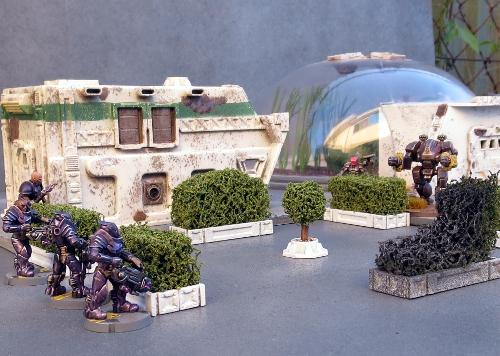
We start with a thick kitchen scourer. For a standard green hedge, you would ideally want a dark green or black scourer, although you could easily use other colours to make alien hedges. The scourer I'm using here is about 20mm thick, and has a really coarse texture. You could use thinner scourers by gluing a couple together, but that may wind up with a visible seam line.
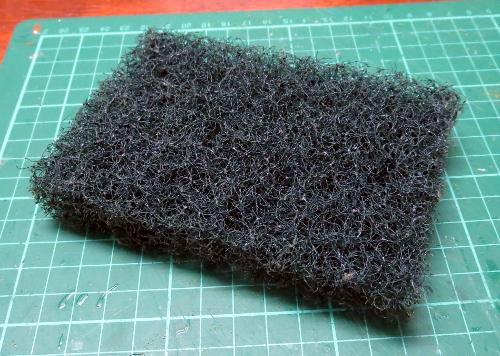
Cut the scourer into strips using a sharp knife or a fine saw. The width of the strips is up to you, depending on how tall you want to make your hedges.
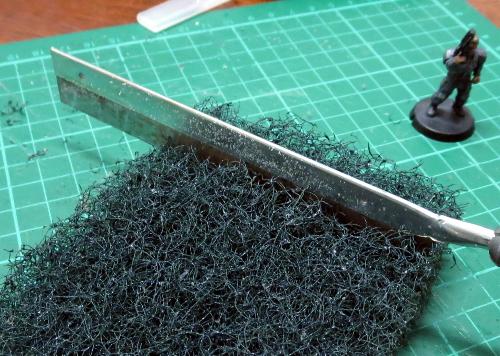
Next, paint the strips of scourer with some PVA glue. Work the glue into the weave of the scourer a little, but try to not leave any big lumps of glue right on the surface, as that may make the outside of your hedge a little blobby.
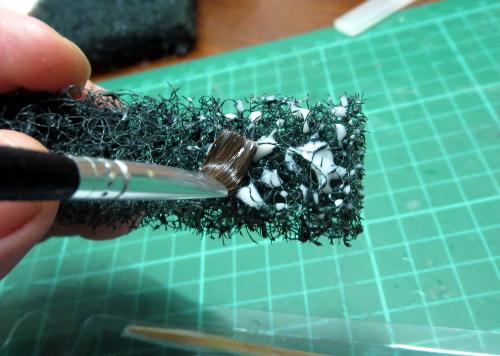
Finally, scatter flock over the glue. You'll get the best results here with a fine grade flock, which you should be able to find in most gaming stores' modeling supply sections or anywhere that sells model trains. Don't use the chunkier, dyed-sawdust stuff - it will just wind up looking like dyed sawdust stuck to a sponge.
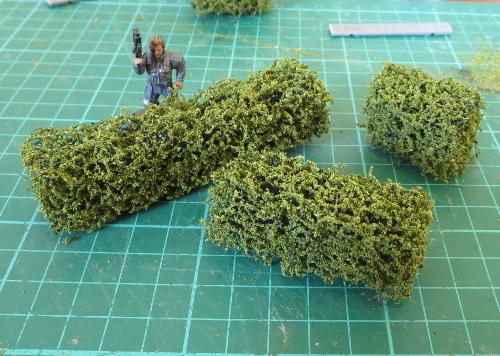
Let the glue dry, and you could easily use your hedges as is to stick onto terrain pieces or scatter around a table. For a slightly more urban look, you can add some boxwork to them using strips of plasticard or the support struts from the Maelstrom's Edge terrain sprue. For the below, I've used a strip of 5mm masonite as a base, which will help to give the hedge section a little more weight.
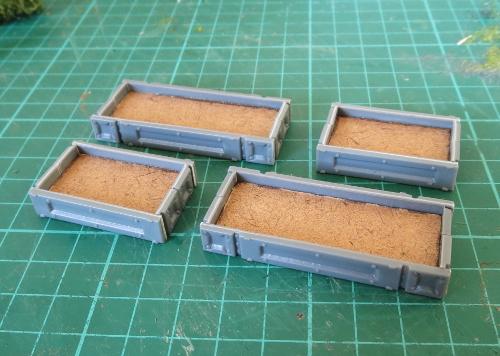
Paint the boxwork up however suits your terrain collection, and then glue the hedges in place with some superglue or PVA glue.

You can mix things up a little by making sections in different heights, to create some lower cover and some full line-of-sight-blocking barriers. Battle damage can be added by cutting or tearing away pieces of the scourer before adding the flock.
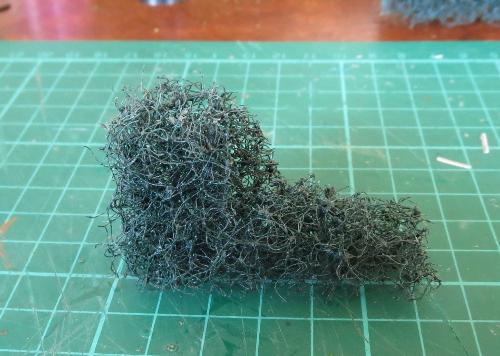
To create a burnt effect, I left the flock a bit patchy around the damaged part of the hedge, and once the glue was dry gave it a quick spray with some flat black, followed by a light dusting of flat grey.
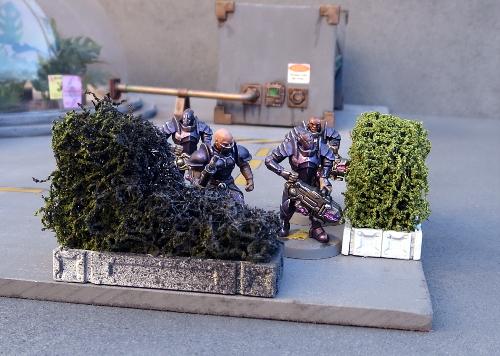
If you want to get really carried away, you can also shape the scourer using a knife or some sturdy scissors and create some topiary features.
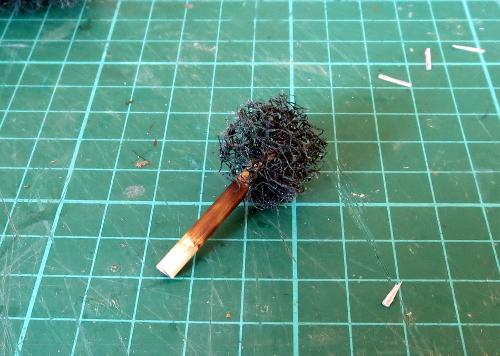
The trunk of this ball topiary was made from a short piece of a wooden skewer, dyed with a little brown ink and then glued into the scourer ball with superglue.
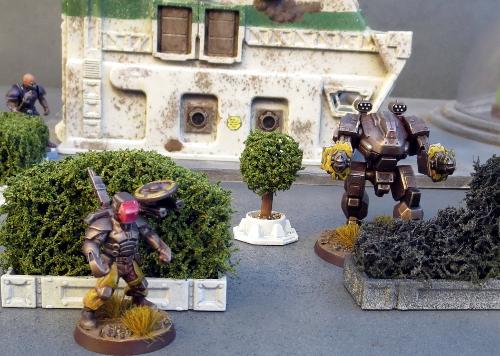
If this all has your green thumb itching, grab yourself some scourers and hedge away! As always, feel free to share your creations on the Comm Guild Facebook page - first one to post a miniature garden maze for their gaming table wins a cookie! (Or possibly just the adulation of the masses and fleeting fame...)
You can find the full range of Maelstrom's Edge models, including the ever-useful terrain sprue, in the Maelstrom's Edge webstore here, and a collection of modeling articles, tutorials and walkthroughs of a wide range of different building and miniature projects in the article roundup here.
Army Spotlight - Epirian Bot Army, Detachment Two
Posted on Monday Jul 24, 2017 at 05:00pm in Models
- by Iain Wilson
Last week, I shared part 1 of an Epirian Bot army that I've been putting together, which you can find here. This week, I'm fleshing it out with a second detachment, to bring the force up to the 120 point mark, suitable for small games.
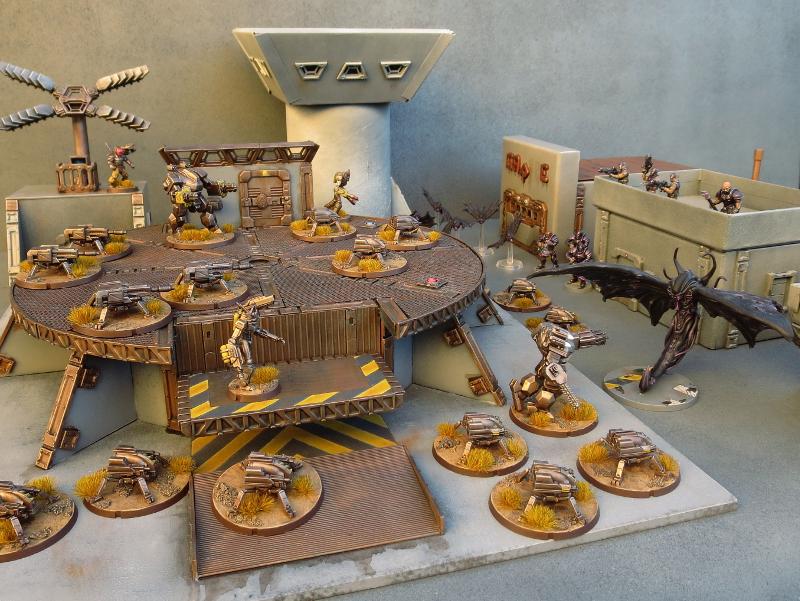
Unsurprisingly in a bot-themed force, the second detachment is comprosed of a whole bunch of extra robots!
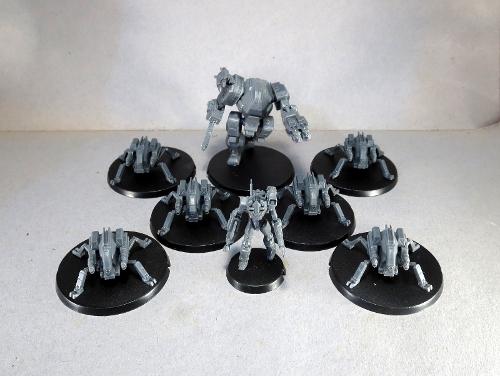
To keep with the bot theme, I wanted the second Command unit to be a Scarecrow rather than another Bot Handler.
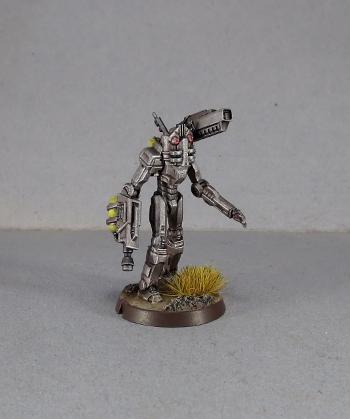
Scarecrows are shifted to a Command slot if you give them a Command Array. That's slightly problematic, since I've been using the Command Array part to put masks on my Scarecrows. I got around this by taking one of the aerials that had been cut off the array and gluing it onto the side of the Scarecrow's head, behind the mask.
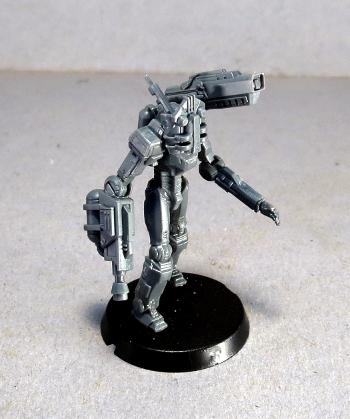
The Scarecrow commander is required to take at least two Core units, so I needed another two units of Spider drones. This time around, I went with Flakk Guns instead of the Cutters, for a bit of close-range supporting fire.
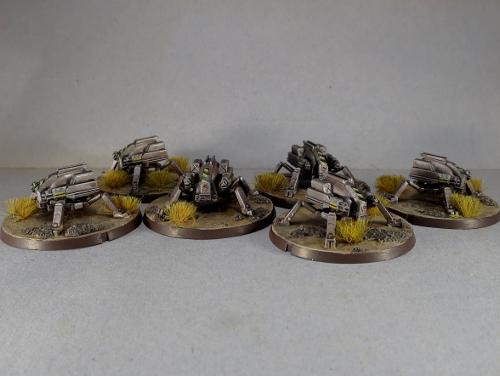
To round out the detachment, I selected another Hunter for my force.

I had built this bot a while back, just to find out how the Hunter would look with a chainsaw in place of the Hydraulic Fist. The saw blade is taken from a Games Workshop Space Wolf kit. Rules-wise, it will still count as the fist.
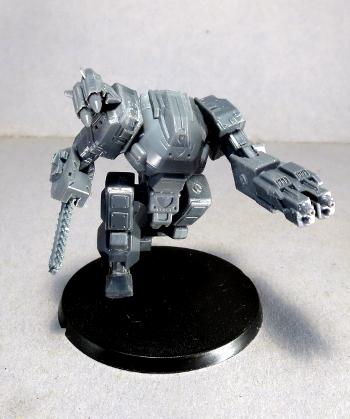
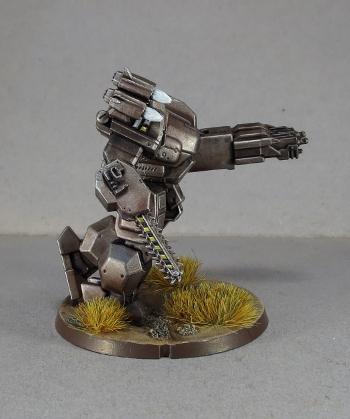
The bases on this detachment were a slight change from last week. I hadn't been entirely happy with the bases on the first detachment, and so I changed to a slightly darker colouring (Vallejo Heavy Brown, washed with Army Painter Strong Tone and then drybrushed with P3 Jack Bone) and added some grass tufts for a little extra pop. To keep things consistent, this obviously meant going back and redoing the bases on the first detachment as well...
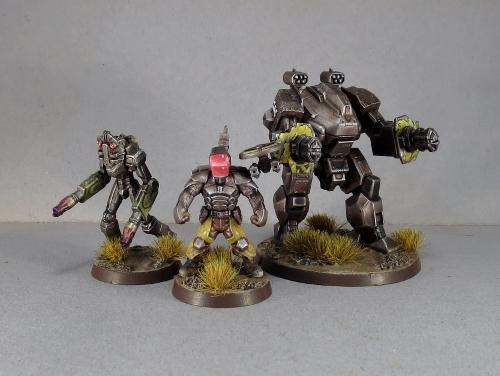
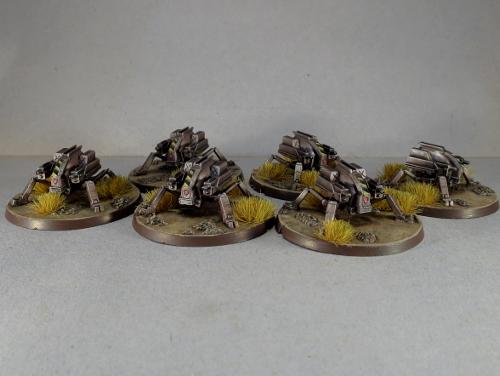
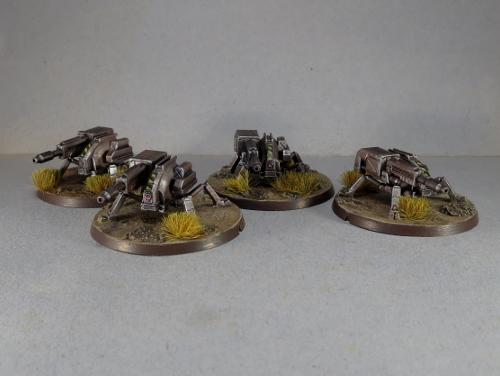
And so, the full force combined:
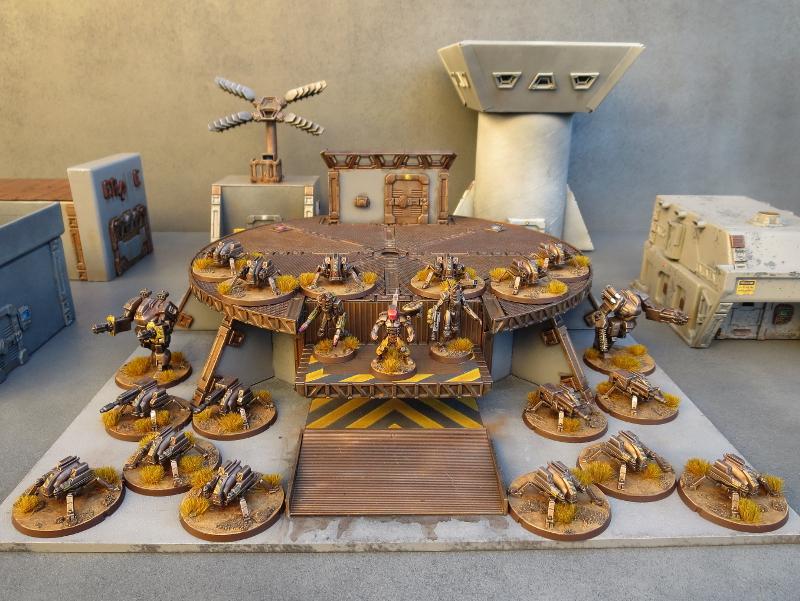
2nd Detachment:
Command: Scarecrow Sniper
- Command Array - 14 points
Core: Spider Drones
- Flakk Guns, replace Apprentice Bot Handler - 8 points
Core: Spider Drones
- Flakk Guns, replace Apprentice Bot Handler - 8 points
Anvil: Hunter-class Warmech
- Suppressor Dual Machine Gun, 2 Strike Missile Pods, Overdrive - 10 points
Total - 40 points.
Combined with Detachment 1: 120 points.
So, what's next for this force?
The obvious choice is to add some Fireflies, and I'll definitely be doing that as soon as I can. I'm also playing with some more homebrew rules, to create a spotter drone that would work in concert with heavy weapon-equipped robot units, possibly by being able to allocate a Command point to a friendly heavy unit within a certain radius that shares LOS to a selected target.

I also built a prototype for a Scarecrow spotlight article a while back, of a Scarecrow that replaces its legs with turbines from the Firefly kit. This was equipped with twin Clingfire sprayers, but I'm thinking that a unit of these equipped with twin Maglock Assault Rifles might be a fun option for encouraging enemy units to keep their heads down.
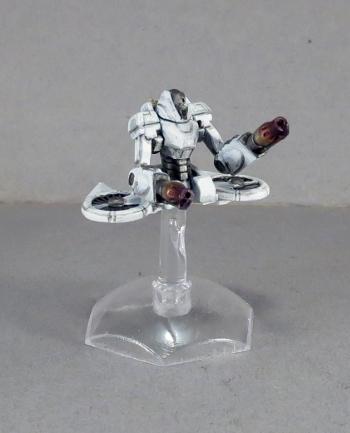
I'm picturing these guys as being able to move freely over obstacles, but being fairly slow moving and not particularly robust, due to the delicate balance required to keep such unwieldy creations airborne.
Stay tuned - I'll post another update on this force when I get these finished off!
If all of these robots are leaving you feeling inspired, you can pick up the full range of Maelstrom's Edge models from the webstore here. As always, feel free to share your creations on the Comm Guild Facebook page!
For other Maelstrom's Edge modeling articles, including tutorials and walkthroughs of a wide range of different building and miniature projects, check out the article roundup here.
Tags: bots conversion epirian modeling painting
Army Spotlight - Epirian Bot Army, Detachment One
Posted on Monday Jul 17, 2017 at 05:00pm in Models
- by Iain Wilson
The Epirian Foundation utilises a wide array of different bots on the battlefield, and the Maelstrom's Edge roster system allows you to create a force that makes the most use of them in place of human troops. And really, why wouldn't you? Robots!
I had a few assorted bots put together in a weathered metal colour scheme for a few previous articles, and so I decided this week that it would be fun to flesh them out into a usable force.

An army, of course, needs a leader. There are a couple of HQ options currently for Epirian forces, but I already had a Journeyman Bot Handler that I put together a while back and then never did anything with, so decided he would have the somewhat dubious honour of being the lone human in the force.
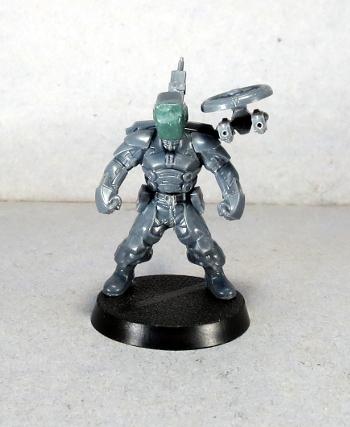
This guy was built from the Bot Handler sprue, with a few modifications.
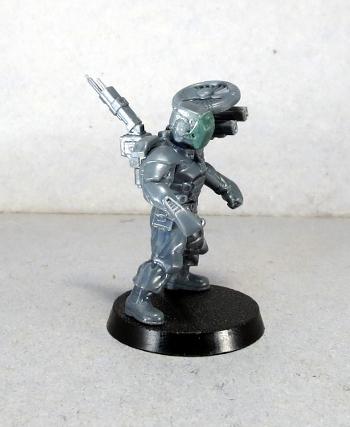
The head was taken from the Contractor sprue with a face shield added with some 'green stuff' putty.
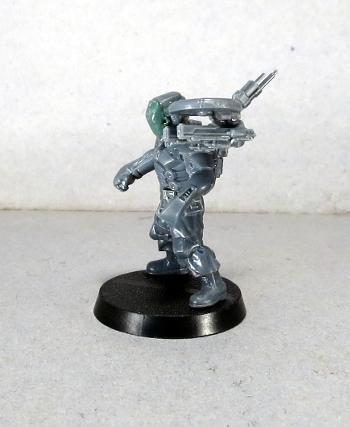
I gave him the spread-leg pose by taking both sets of legs from the handler sprue and cutting them apart vertically through the groin, and gluing the opposing halves with the matching straight legs together.
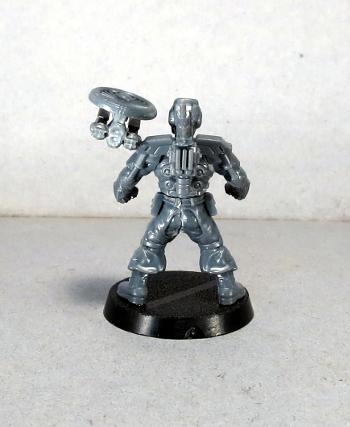
Rather than having him holding his pistols, I thought a mini gun-drone would be fun, so I mounted two pistols under a single turbine taken from a Firefly drone. This little drone is pinned to the Journeyman's shoulder, to give it the appearance of flight without needing a flight stand.
Painting was kept fairly simple, to match the bots that I had already built, and so used the weathered metal process that I've shown in several articles now - red undercoat, followed by a coat of brown, then a metal layer, and then a wash with Army Painter Strong Tone.

Yellow chaps and a shiny red faceplate tie in with the more subdued highlights used on the rest of the force while letting him stand out a little from the crowd of bots.
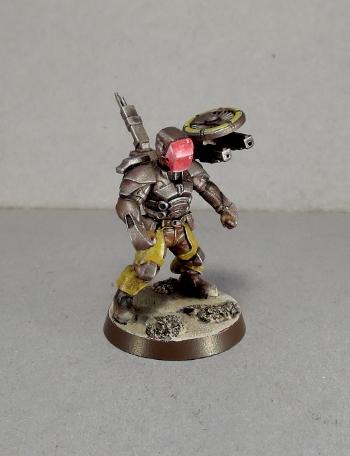

With paint in place, the Journeyman joins the Hunter mech that I originally painted up for the weathered metal tutorial, and a slightly modified Scarecrow that I built for a spotlight article on the lanky, elite units.

The army wasn't going to get far without troops, and so I grabbed a few Drone sprues and put together two units of Spider drones. To stick with the bot-theme, I made use of the upgrade option to replace the Apprentice handler who normally accompanies units of Spiders with a third drone instead.
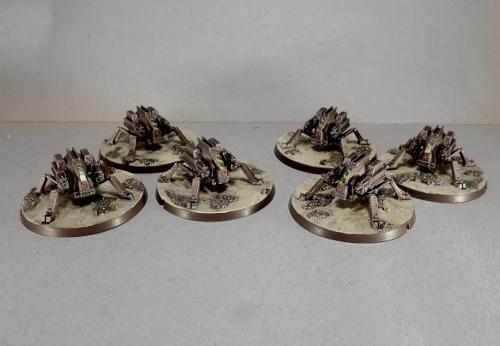
To round out this first detachment, I added some fire support from two units of Scorpion Drones. These are a home-brew unit that I created for an article a while back, rather than a standard Maelstrom's Edge unit - You can find their rules card and a tutorial for building them here.
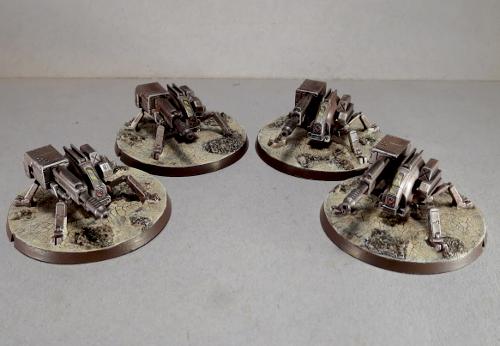
That rounds out the first detachment, which comprises around half of the planned force. Roster-wise, it looks like this:
Command: Journeyman Bot Handler
- second pistol, Command Booster - 17 points
Core: Spider Drones
- replace Apprentice Bot Handler - 9 points
Core: Spider Drones
- replace Apprentice Bot Handler - 9 points
Hammer: Scarecrow Sniper
- 2 linked clingfire sprayers, Overdrive - 5 points
Anvil: Hunter-class Warmech
- 2 flakk cannons, 2 cluster missile pods - 20 points
Anvil: Scorpion Drones - 10 points
- 2nd unit (Multi-unit selection) - 10 points
Total - 80 points.
Next week: Detachment 2.
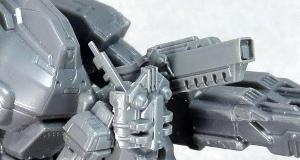
Spoiler: There will be robots!
If you would like to build your own robot army of doom, you can pick up the various Maelstrom's Edge kits from the webstore here. As always, feel free to share your creations on the Comm Guild Facebook page!
For other Maelstrom's Edge modeling articles, including tutorials and walkthroughs of a wide range of different building and miniature projects, check out the article roundup here.
Crafting Tales from the Edge
Posted on Thursday Jul 13, 2017 at 02:10pm in Fiction
In the summer of 2014 several members of the team had the opportunity to attend WorldCon in London and give a sneak-peek of Maelstrom's Edge to some of the world's best science-fiction authors. The aim? To showcase our universe and convince them to lend their awesome storytelling talents to our project. Presenting the backdrop, artwork, and prototype models, many of the authors we pitched to came away impressed with both our vision and our commitment to building a long-lasting IP. We came away from the London Excel centre having signed up a great mix of highly-acclaimed established voices and up-and-coming superstars to contribute to our project.
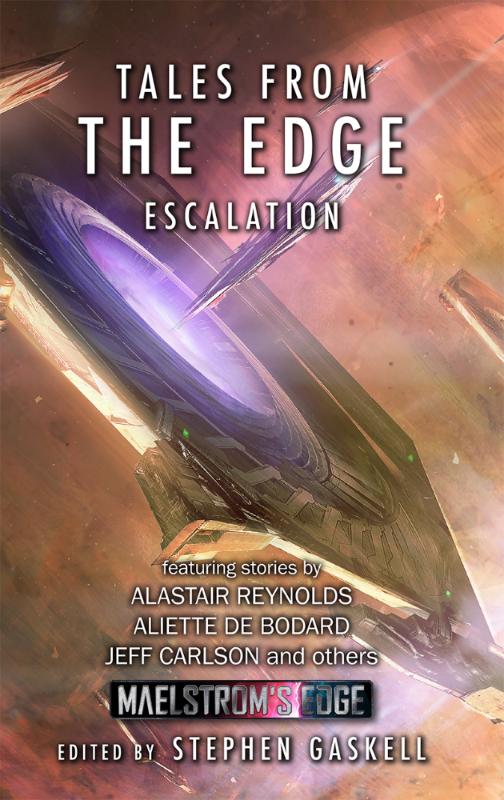
Tales from the Edge: Escalation is the result of that fruitful few days at science fiction’s biggest convention. The anthology brings together a wealth of talent contributing short fiction work to the Maelstrom's Edge universe:
Alastair Reynolds
With over a decade of experience as a professional astrophysicist to back up his writing chops, Alastair Reynolds is deservedly called the "reigning master of the intergalactic space opera", and brings a compelling edge of hard-SF to his unique brand of galaxy-spanning science fiction. Author of the Inhibitor trilogy that kicked off with the seismic Revelation Space and ended with the chilling Absolution Gap, Alastair's star has only risen over the last twenty years, and has been nominated for the prestigious Arthur C. Clarke Award three times.
http://www.alastairreynolds.com/
Here's what Alastair said about getting to play in the Maelstrom's Edge universe:
"Maelstrom's Edge is something different: an SF game universe put together with real originality and incorporating some genuinely clever and inventive thinking. There are enough worlds and stories waiting to be explored to last a lifetime..."
With his gritty blend of dark sci-fi, speculative science, and galaxy-spanning drama he is a perfect match for the Maelstrom's Edge universe and we're delighted to have him on board with our opening story, ‘Remainers’, in which a ship’s captain accepts a client’s dangerous request to return to a world doomed by the Maelstrom.
Rob Ziegler
Author of the spectacular Seed, which Paolo Bacigalupi described as "A hungry beast of a book, rippling with slaughter and sex, powerhouse action, surreal post-human horrors and bigger-than-life heroes", Rob's work combines kinetic action, bleak landscapes, and characters drawn from the grimy underbelly of society. As such we think he is perfect to help us flesh out some of the stories happening at the margins of the Maelstrom's Edge universe, particularly those involving the Broken, our very own faction of survivalists who mix the high-tech and the squalid together with the violent and the tender. ‘Little Bots’, Rob’s story in ‘Escalation’, is a terrific tale of a group of orphans, sneaking and tricking their way to survival.
http://zieglerstories.com/
Jaine Fenn
Described by SFX Magazine as "A major new talent" on the release of her debut novel, Consorts of Heaven, Jaine Fenn has proceeded to flesh out her Hidden Empire series, charting seven-thousand years of future history as humankind adventures among the stars. Known for writing tense and fast-paced stories set in vivid locales, we felt Jaine would create the kind of gripping fiction perfectly suited to the universe of Maelstrom's Edge. For her first story in our universe, Jaine set her sights on two of our future factions – telling the story of a noble Champion of the Artarian Remnant Fleet, amongst the ragtag flotilla of a Broken fleet, in the cracking short story ‘Over You’.
http://www.jainefenn.com/
Jeff Carlson
In the Plague Year trilogy Jeff Carlson unleashed a nanoplague on humanity that killed all warm-blooded life below 10,000 feet. In his Frozen Sky novels humankind discovered a deadly species in the icy waters of Jupiter's ice moon, Europa. Who better than this Philip K. Dick Award Finalist to help bring the Maelstrom's Edge universe to gripping life? When we told him about the Maelstrom's Edge universe and invited him to spread his fictional wings he had the following to say:
"These days I write sci fi and tech thrillers that, I hope, are chock full of monsters and chills and cutting edge science. When I heard about Maelstrom’s Edge, I begged its designers to let me play in their sandbox. An unstoppable wave of hellish energy. Civilizations destroyed. Terraforming corporations, mech, refugees, cults, strange planets. Man, that’s what I do!!!!"
Jeff’s story ‘The Spaces Between Us’ is something both beautiful and brutal, telling a tangled family tragedy on a world with something truly worth saving.
http://www.jverse.com/books/
Aliette de Bodard
Nominated for multiple Hugo, Nebula, and BSFA awards, and winner of the Nebula and Locus awards, Aliette de Bodard is a highly-acclaimed author who will bring brilliant prose allied to poignant characters to the Maelstrom's Edge universe. Subverting the usual tropes for original twists, and substituting by-the-numbers heroes for vivid individuals deeply entwined with familial and cultural shackles, we were really excited to see what Aliette did with the apocalyptic backdrop of Maelstrom's Edge, and her story, ‘Losses We Bear’ is a superb demonstration of her skills. http://aliettedebodard.com
Tomas L. Martin
Well, that’s me! Together with Stephen Gaskell, I’m one of the lead writers who helped develop the background to the Maelstrom’s Edge universe, as well as together writing the short stories that made up our first collection, ‘Tales from the Edge: Emergence’, and the two Maelstrom’s Edge novels, ‘Faith’ and ‘Sacrifice’. When not writing for Maelstrom’s Edge, I’m a lecturer in materials physics at the University of Bristol, as well as occasionally dabbling in other fiction endeavours! My story, ‘Fleet Champion’ is a little introduction to the tangled politics and heated contests of the Remnant Fleet and the power-suited Champions that compete for the honour and reputation of their noble houses.
http://www.tomaslmartin.com
Jonathan Cooper
Coming via Wolverhampton, Dublin and London, Jonathan Cooper is a novelist and occasional journalist now living in Amsterdam. He has written on film, TV and pop culture for the Mirror and the Independent and has short fiction published in the New London Review and Scrivener Creative Review. He is also the author of Lethbridge Stewart: The Showstoppers, a new novel featuring Doctor Who's very own Brigadier. In this anthology Jonathan gives us ‘The Daughter of Arin’, where a Comm Guild courier delivers a strange package that leads to an increasingly chaotic conspiracy.
Karin Lowachee
Winner of a boatload of awards including Warner Aspect First Novel, Prix Aurora Award 2006, and Spectrum Award 2006, not to mention twice being shortlisted for the Philip K. Dick Award, Karin Lowachee's Warchild Universe explores the experience of fictionalised child soldiers learning to survive in a war-torn galaxy. When we asked her to expand on what drew her to Maelstrom's Edge universe she had the following to say:
"In a genre that can literally explore anything the imagination envisions, the opportunity to sink my teeth into a doomsday event of galactic proportions was too good to pass. Everything about Maelstrom's Edge speaks to my creative inclinations: high stakes, complex characters, an expansive setting, and a sense of wonder. The possibilities for exploration both external and internal are endless, and my fascination with the human condition—our frailties as well as our strengths—is something I will explore. A psychological close-up of what a random band of survivors on a frontier planet are willing and able to do to reach their destination—and presumably their saving grace to get off-world ahead of the Maelstrom—will take an unflinching look at the nature of selfishness, exploitation, compassion and love."
Karin's tale ‘The Flesh of the World’ explores a lawless, frontier-type world that has been abandoned by the corporations, leaving the population alone to face the coming Maelstrom.
http://www.karinlowachee.com
Stephen Gaskell
The other half of the Maelstrom’s Edge lead writing team, Stephen is a prolific and talented writer both of fiction and for games. When not writing for Maelstrom’s Edge, Stephen works as a Senior Writer for Amplitude Studios, where he recently completed work on the popular 4X strategy title, Endless Space 2. His fiction has appeared in Clarkesworld, Interzone, Years Best Military SF, and elsewhere, and he is currently seeking representation for his debut novel, The Unborn World, a dystopian eco-thriller set in Lagos, Nigeria. An alumnus of University College, Oxford, he holds degrees in physics and artificial intelligence. Stephen’s contribution to the anthology is the fantastic ‘A Keeper’s Duty’, which explores the moral dilemma of a convert to the Karist Faith, growing up to become one of the Keepers who looks after the otherworldly alien creatures known as Angels.
http://www.stephengaskell.com
Liz Williams
With degrees in philosophy and artificial intelligence, a mother who was a gothic novelist, and a father who was a part-time conjurer, it is no exaggeration to say that Liz William's is one of the most original voices working in science fiction today. Short-listed for the Philip K. Dick Award for her novels no less than four times, Liz is also a master of the short form with her work appearing in many Year's Best anthologies. Writing dark and strange yet utterly compelling fiction, Liz's piece for our Maelstrom's Edge anthology is titled "’Moon Desert’ and is a fantastic read.
http://www.amazon.co.uk/Liz-Williams/e/B001HCXOL2
Maelstrom's Edge has a comprehensive long term fiction plan which we give as much attention as the game itself. From day one we've been trying to develop a universe which will grab the interest of anybody who has even a passing interest in Science Fiction, and with some of the best sci-fi authors in the world committing stories into the anthology ‘Tales From The Edge: Escalation’, Maelstrom's Edge is going from strength to strength, with plenty more to come from us in future.
Terrain Spotlight: Experimental Cybel Gate
Posted on Monday Jul 10, 2017 at 05:00pm in Models
- by Iain Wilson
As the Maelstrom's apocalyptic conflagration closed in on the planet Devlin IV, rumours began to circulate amongst those still desperately trying to find passage off-world that scientists in a secret Epirian Foundation facility had been working on a new kind of Cybel gate that might prove to be their salvation. Whilst most Cybel gates are massive, space-borne affairs, this gate would supposedly operate from the planet's surface! While the rumour would ultimately lead to disappointment, as the project had been a dismal failure, it nevertheless gave temporary hope to many who had given up on escaping the Maelstrom's wrath and fueled a frantic search for this device.
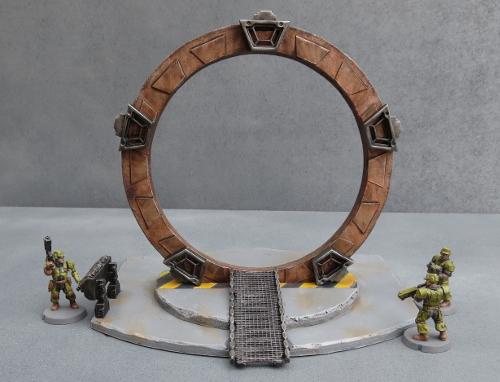
I had an idea a while back for a table themed around a Cybel gate research facility, where the experimental gate would form a centrepiece that would double as both a cool focal point and a potential objective for scenario-driven games. Capturing a resource such as this would, of course, be a worthy goal for any of the various forces encountered in Maelstrom's Edge, and there is all sorts of additional potential for thematic events when the gate is activated. Below is what I came up with, built from foamcore, cardboard, and components from the Maelstrom's Edge terrain sprue.
I started out creating the basic shape for the gate by tracing two concentric circles onto a sheet of 5mm foamcore and cutting the resultant ring out with a hobby knife.
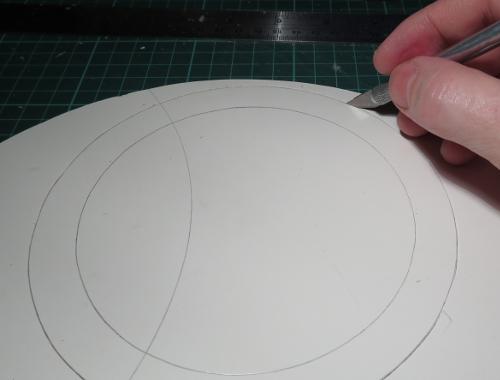
I then used the foamcore ring as a template to make two more rings from thick card.

The circle cut from the inside of the foamcore ring was the perfect size to act as a base, with a channel cut down the middle for the ring to sit in.
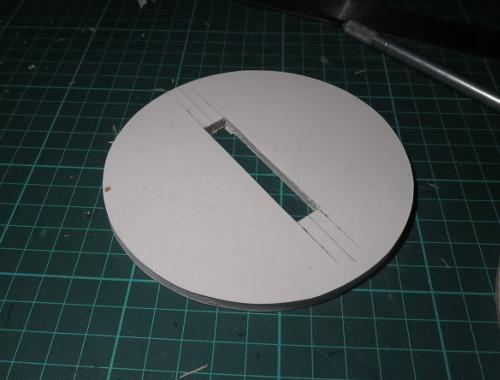
The three rings were glued together, and set in place to check the fit.
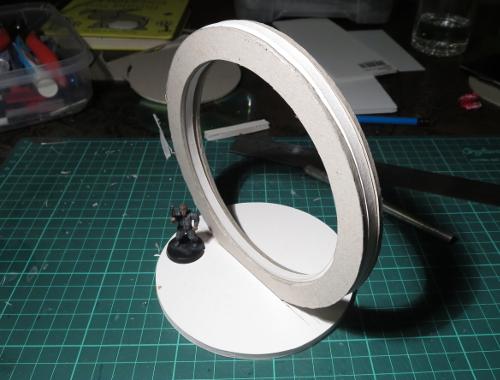
Next, I cut a bunch of trapezoid shapes from plasticard, sized to fit neatly inside the trapezoid window from the Maelstrom's Edge terrain sprue.
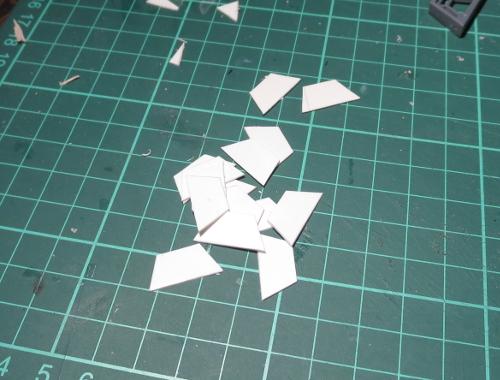
These were glued at intervals around one side of the ring.
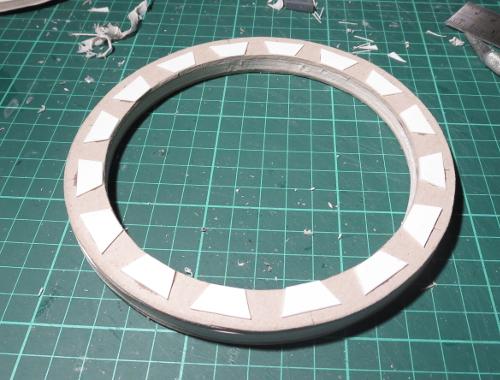
Over these, I glued 5 trapezoid windows, with power units cut from the bottom of the energy-fence posts glued around the outside of the ring.
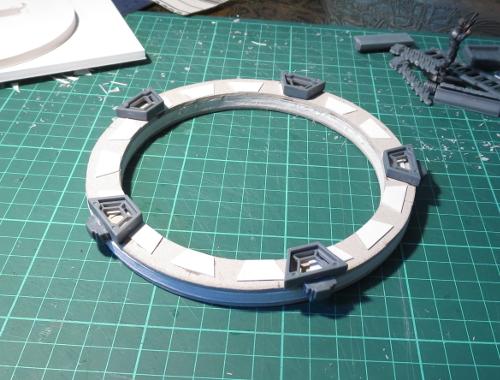
I took a ladder and cut the outside edges off with a razor saw.
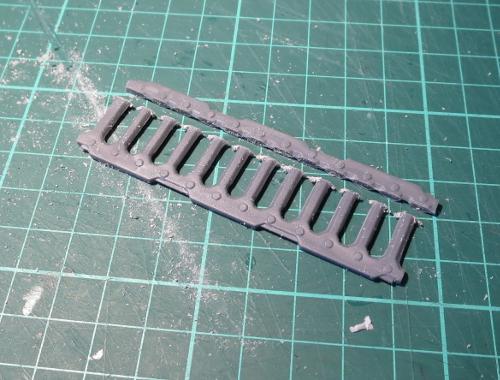
A second ladder was glued to a sheet of flyscreen, and then the flyscreen trimmed around the edges of the ladder and the cut pieces from the first ladder glued onto either side.

The base was bulked up a little with another layer of foamcore.
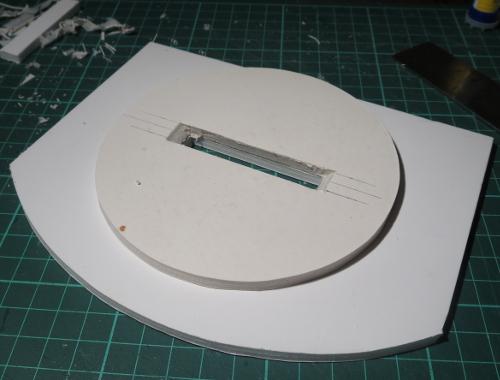
I then used a file to carve out an angled ramp down the front of the base.
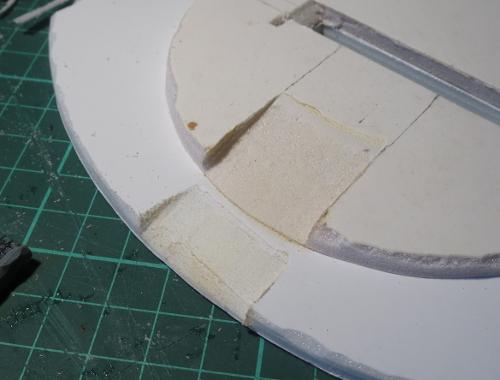
The ladder assembly slots neatly into the ramp recess.
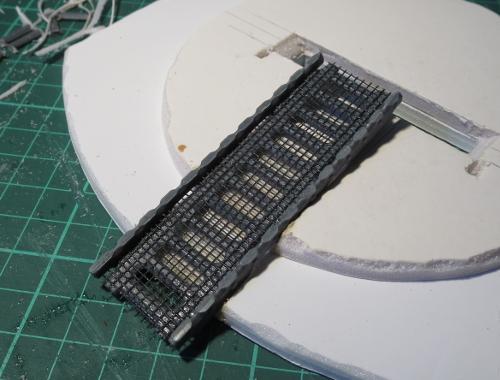
Finally, I put together a control panel using a light fixture and three trimmed computer panels.
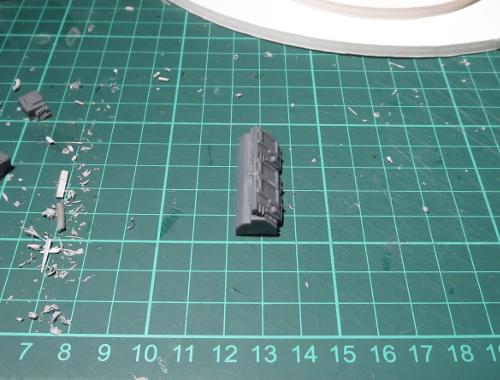
With the addition of some legs made from trimmed down energy-fence posts, the control panel was glued in place, and the gate was ready for painting.
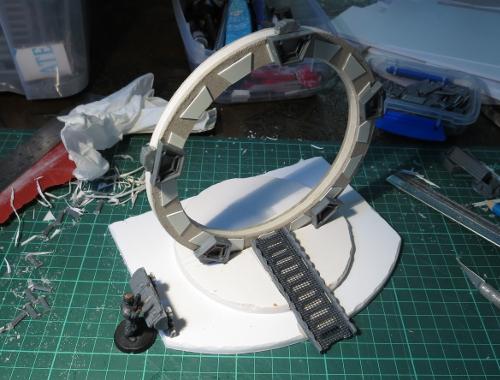
I wanted a bit of contrast in the gate assembly, so decided to go with a coppery ring and darkened steel details. To get started, I sprayed the ring with Army Painter Army Green, partly to give a nice base layer for the copper and partly because I didn't have a lot of time for painting this week, and the Army Painter sprays dry nice and quickly...
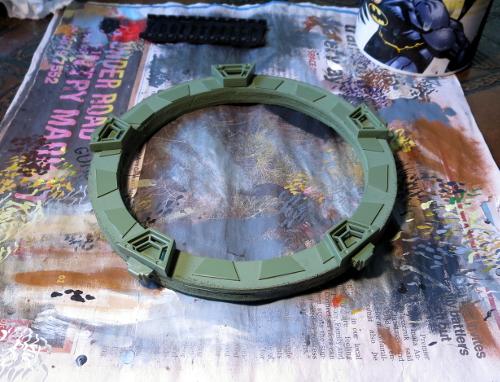
Over the green, I did a couple of coats of some old Citadel copper that I had laying around.

The base was sprayed with a medium grey colour.
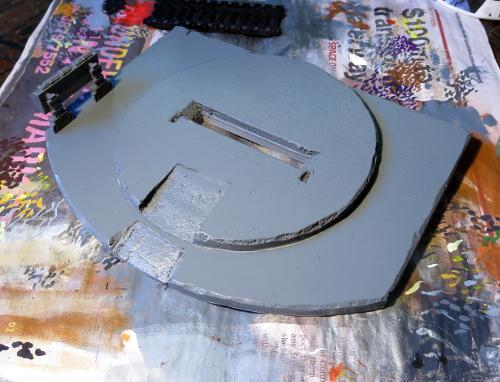
I then picked out the steel parts with black. It's a little hard to see in this lighting, but I also drybrushed the base with a light grey and added some dirt scuffing with some lightly drybrushed brown.
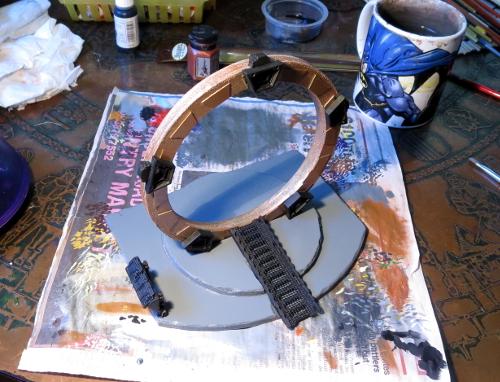
The ring was given a couple of coats of Army Painter Strong Tone, and the steel parts drybrushed with P3 Pig Iron and then washed with Army Painter Dark Tone.
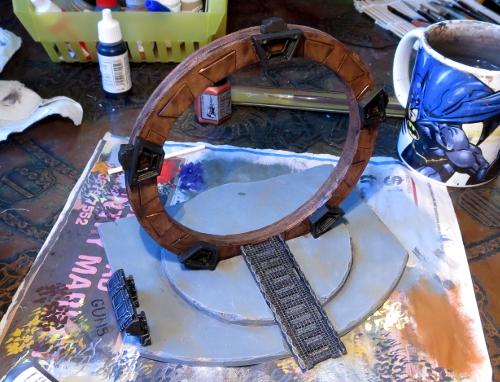
Finally, the control panel screens and some hazard lines were added, and the ring was given a light drybrush with silver to lift the edges a little.
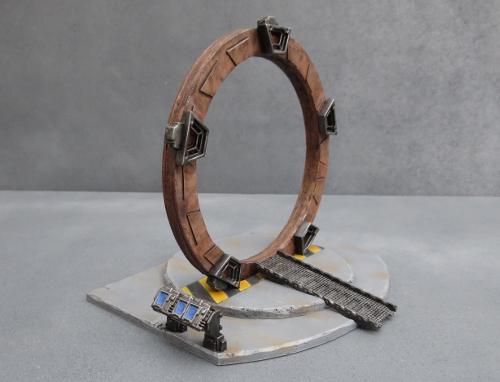
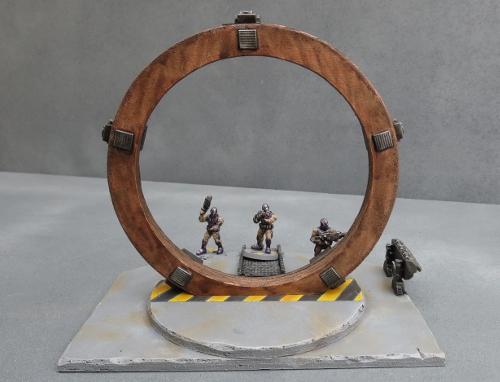
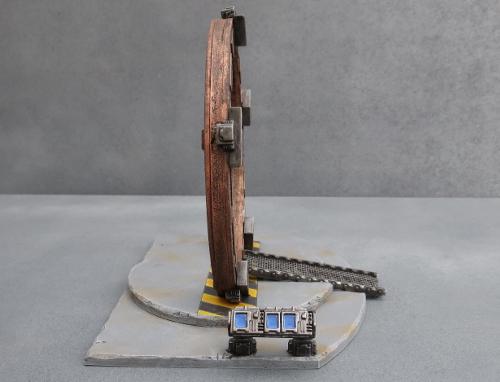
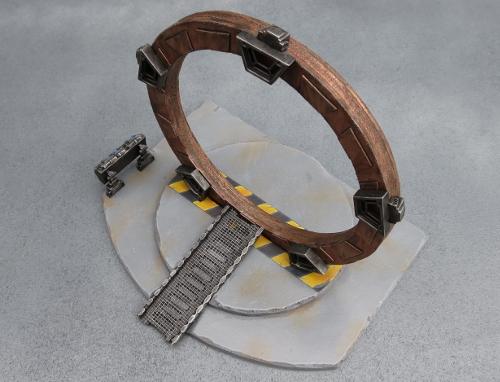
If you would like to build your own experimental Cybel gate, you can pick up the Maelstrom's Edge terrain sprue from the webstore here. As always, feel free to share your creations on the Comm Guild Facebook page!
For other Maelstrom's Edge modeling articles, including tutorials and walkthroughs of a wide range of different building and miniature projects, check out the article roundup here.
